Table of contents
- Earth Fed Muscle Plant Protein Review
- 🔑 Earth Fed Muscle Plant Protein Review, TL;DR
- 🛡️ How I Approached This Earth Fed Muscle Review
- 📖 Earth Fed Muscle Plant Protein Review Details
- 🔑 Where to Buy Earth Fed Muscle? TL;DR
- 🔑 Is Earth Fed Muscle Amino Spiked? TL;DR
- 🔑 Is Earth Fed Muscle 3rd Party Tested? TL;DR
- 🔑 Plant-Based Protein Comparison: Earth Fed Muscle Vegan Protein Powder, TL;DR
- 🥤 How to Mix Earth Fed Muscle Protein Powder
- 👌 Common Ground Chocolate: Earth Fed Muscle Best Flavor?
- 🔑 Earth Fed Muscle Plant Protein Ingredients, TL;DR
- 🔑 Earth Fed Muscle Plant Protein Nutrition Facts, TL;DR
- 📋 Earth Fed Muscle Plant Protein Review FAQ
- 🏁 Earth Fed Muscle Plant Protein Review
- 🧐 Earth Fed Muscle Plant Protein Review Round-Up
- 📑 Earth Fed Muscle Plant Protein Review Sources
Earth Fed Muscle Plant Protein Review
In this Earth Fed Muscle Plant Protein Review, we pull back the curtain on a formula that markets itself as clean, organic, and gut-friendly—but the details tell a more complicated story. What we discovered is a powder that nails taste and mixability, yet struggles to back up its “organic” claims with certification or ingredient transparency.
The advertised 15 g of protein per scoop doesn’t fully match the digestibility math, landing closer to 10–12 g usable protein. Readers will learn exactly where the marketing matches reality—and where the shine fades once you dig into the label.
Summary
Earth Fed Muscle Protein Review: Tastes Great, But Does the Label Hold Up?
In this Earth Fed Muscle Protein review, you’ll find a shake that nails flavor and mixability but stumbles on transparency. The label boasts 15 g of protein, yet digestibility math drops it closer to 10–12 g usable. Natural flavors rank high in Chocolate and Vanilla, which raises questions when the brand leans so heavily on purity marketing. Still, Chocolate Peanut Butter strikes a balance between flavor and density. This Earth Fed Muscle Protein review indicates it is effective for casual users, but not for athletes seeking precise muscle protein synthesis. Consider this Earth Fed Muscle Protein review your shortcut to deciding if taste outweighs proof.
Pros
- Excellent chocolate flavor and smooth mixability
- Soy-free, gluten-free, no artificial sweeteners
- NSF listed and lot-tested for safety
Cons
- “15 g” per scoop translates to closer to 10–12 g usable protein once digestibility is factored in.
- “Organic” claim lacks a USDA seal or certifier
- Natural flavors sit high on the ingredient panel in Chocolate and Vanilla
- Amino acid profile is manufacturer-supplied with no third-party verification
- $60 per tub feels steep without verified sourcing or certifications
Earth Fed Muscle Common Ground Plant Protein Review: watch the full video breakdown if you don’t want to read the article.
🔑 Earth Fed Muscle Plant Protein Review, TL;DR
In this Earth Fed Muscle review, the pitch is simple: a clean, organic-forward vegan blend built on pea, hemp, and goji. The tub leans hard on “short ingredients, big taste,” soy-free, gluten-free, and no artificial sweeteners—a marketing story that looks airtight at first glance.
But here’s the fine print. The label shouts “organic” without a USDA Organic seal or certifier. “Natural flavors” sit high on the panel—second in Vanilla, third in Chocolate—leaving transparency gaps about what’s really inside. Protein density averages just 43%, which means the 15 g headline scoop delivers closer to 10–12 g of usable protein. Leucine clocks in at ~1.1 g per scoop, meaning you’ll need two to three scoops to trigger muscle protein synthesis. Every amino acid number is manufacturer-supplied with no third-party audit, so the trust gap remains.
That doesn’t make it fraudulent, but it does make it more lifestyle shake than performance fuel. If your goal is weight management, clean-label snacking, or just a velvety chocolate sip that mixes like a dream, Earth Fed Muscle Plant Protein is a pleasure. If your priority is transparency, amino verification, or protein efficiency, you’ll find stronger options.
Bottom line: Flavor and mixability are the real strengths of Earth Fed Muscle Plant Protein. However, inflated label math, the lack of an organic certifier, and self-reported amino data all drag it down. This Earth Fed Muscle Protein review closes with a final score of 29/50 (58%)—Ehhh: great taste, but not the transparency benchmark.
🛡️ How I Approached This Earth Fed Muscle Review
When I sat down to write this Earth Fed Muscle Review, my process always starts with the basics—hands-on testing, label scrutiny, and a clear look at how the product holds up under real-world use. The marketing badges, influencer hype, or glossy branding do not sway me. I’m a certified strength and conditioning specialist (NSCA) and a certified sports nutritionist (CISSN), which means my approach blends science with practical application. If the protein doesn’t deliver, I’ll call it out.
This Earth Fed Muscle Review, like every one I publish, is 100% independent. I purchased my own tub, tested it against the claims, and fact-checked the nutrition math. Whether it’s protein density, amino acid transparency, or the credibility of “organic” claims, I cut through the noise so you know what’s actually inside the scoop.
Reviews should be useful beyond the article. That’s why I break down taste, mixability, and performance in simple terms, and expand on these findings visually over on my YouTube channel. There, you’ll see how the shake actually mixes, pours, and tastes—because some things can’t be captured on paper alone.
🌟 At the end of the day, my reviews aren’t written to please brands; they’re written to give you clarity. This Earth Fed Muscle Review is no different: if you want straight talk about what this protein does well and where it falls short, you’re in the right place.
📖 Earth Fed Muscle Plant Protein Review Details
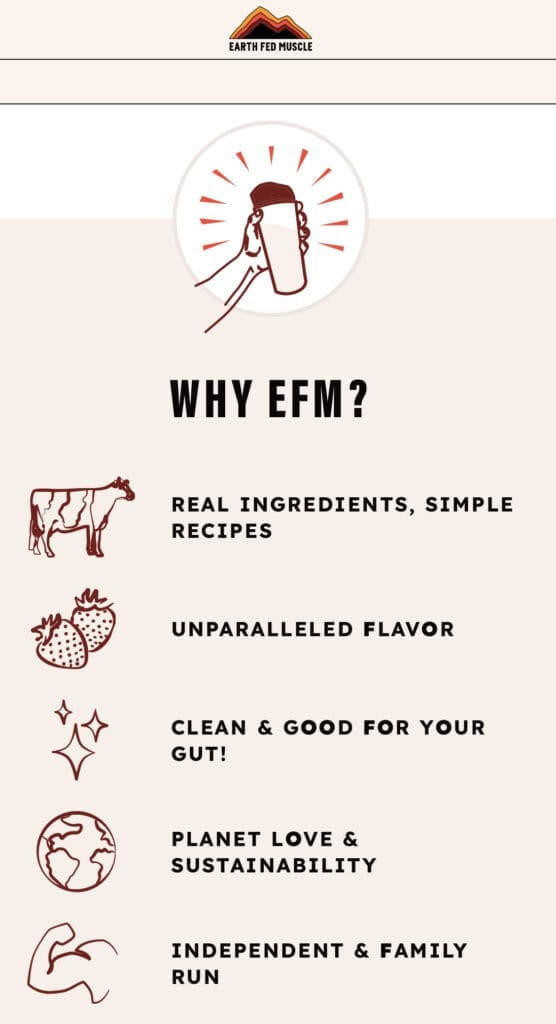
Earth Fed Muscle builds its Common Ground Plant Protein on a clean, aspirational story: “Our commitment to our collective home is real—that’s why it’s in our name. That’s why we sourced the best organic plant proteins we could find and blended them with organic cacao and coconut-based MCT oil for the best-tasting plant protein on this big green Earth” (Earth Fed Muscle). It’s a pitch that leans on transparency, sustainability, and small-batch authenticity—traits buyers crave in a crowded plant-based category.
The brand highlights its pillars as real ingredients, simple recipes, unparalleled flavor, and clean & good for your gut. Add in “independent & family run,” and the positioning shifts from mass-market commodity to boutique craft. The Earth Fed Muscle review found this story credible in flavor and mixability—Chocolate delivers a velvety, grit-free sip—but flagged cracks where marketing and documentation diverge.
For example, the company openly contrasts plant and grass-fed proteins, admitting “plant proteins don’t cause the same level of growth and recovery as animal nutrients do,” while still arguing for the ethical, digestive, and sustainability edge of plant blends (Plant Protein vs Grass-Fed Protein). That honesty deserves credit. Yet, the “organic” claim on tubs lacks a USDA seal or certifier disclosure, which makes the promise feel softer than the branding suggests.
Earth Fed Muscle Plant Protein is marketed with integrity and delivers on taste, but the proof stops short at certifications. The values resonate—sustainability, simplicity, independence—but without verified organic backing or third-party amino data, the review found it better positioned as a lifestyle shake than as a clinical-performance protein.
🔑 Where to Buy Earth Fed Muscle? TL;DR
The best place to buy Earth Fed Muscle depends on whether you’re after convenience or long-term value. Direct from EarthFedMuscle.com, you unlock first-time buyer discounts, a loyalty program, and profession-based perks—“20% off everything for veterans and active duty, 15% off for medical professionals and first responders, and 15% off for teachers.” You also get a 30-day return policy, provided the tub is mostly full, which Amazon doesn’t match.
Amazon’s upside is speed. Prime shipping gets you a tub of Earth Fed Muscle Protein in two days, often bundled into an existing order. But that convenience comes with trade-offs: no loyalty rewards, no professional discounts, and no returns on opened supplements.
Bottom line: If you’re experimenting with one tub, Amazon is fine. But if you’re serious about making Earth Fed Muscle Protein Powder part of your routine, buying direct is smarter—the discounts stack, the rewards build, and the return policy provides peace of mind.
🛒 Where to Buy Earth Fed Muscle?
For this review, I purchased my tub of Earth Fed Muscle Protein Powder directly from the Earth Fed Muscle website and scored a first-time order discount. Buying direct also unlocks perks Amazon can’t touch: EFM runs a military, first responder, and teacher discount program, offering “20% off everything for veterans and active duty, 15% off for medical professionals and first responders, and 15% off for teachers.” They also operate a rewards and loyalty program, allowing buyers to accumulate points toward future orders.
On the flip side, Amazon does sell Earth Fed Muscle, but without the extras. Prime members get free two-day shipping, but there’s no returns policy for opened supplements and no loyalty or professional discounts. For some, the convenience of tossing a tub into an existing Amazon cart wins out, but you’re trading flexibility and long-term savings.
Bottom line: If you want fast shipping and a one-time buy, Amazon is fine. But if you’re serious about sticking with Earth Fed Muscle Protein Powder, buying direct is smarter—stackable discounts, loyalty rewards, and a 30-day return policy add up to more value for the same $60 tub.
| Where to Buy Earth Fed Muscle | ||
| Retailer | Earth Fed Muscle | Amazon |
| Shipping & Handling | Free S&H on orders $150+Standard S&H is $10.99 | Prime Members get free 2-day shipping |
| Subscription Savings | 25% off recurring ordersSavings for a variety of professionsVarious coupon sales based on major holidays | No S&S |
| Money-Back Guarantee | 30-day | No returns on supplements |
| Payment Options | Standard payment options and Shop, PayPal, Venmo, Google Pay | Standard payment options |
| Price | $59.99 per container (30 servings) | $59.99 per container (26 servings) |
| Price per Serving | $2.00 (or $1.50 with 25% S&S) | $2.00 (or $1.60 with 25% S&S) |
💸 Earth Fed Muscle Return Policy
Earth Fed Muscle keeps its return policy relatively straightforward, but there are a few fine-print details worth calling out. According to their official Returns and Exchanges page, “If for some reason you are unhappy with your purchase, we will do our best to make things right.” That sounds reassuring, but the rules kick in quickly. You’ve got 30 days from delivery to initiate a return, and supplements must be at least 80% full if opened. Apparel needs to be unworn and unwashed with original tags. International orders? Not eligible at all.
How It Works: To start, you’ll need to email their support team at support@earthfedmuscle.com. Refunds and exchanges only apply if you purchased directly from EarthFedMuscle.com, not from Amazon or a third-party retailer. Customers cover return shipping, and once the product is checked, refunds (if approved) hit your original payment method within three business days—though Earth Fed Muscle notes it can take “up to 2 weeks for the refund to appear on your statement.”
The Catch: The brand explicitly reserves the right to decline returns if it detects “abuse or repeated trend of abusing our return and exchange policy.” That kind of language is unusual in supplement policies and suggests a tighter rein than more generous competitors.
Bottom Line: The Earth Fed Muscle Protein Powder lineup is covered under a workable—but not consumer-friendly—return system. You’ll need to act fast, keep your tub mostly full, and accept the shipping costs if it doesn’t work out. For a $60 product, this lack of flexibility might give cautious buyers pause compared to brands offering no-questions-asked money-back guarantees.
Value: 4.5 of 10.
Buyers will be drawn to Earth Fed Muscle Plant-Based Protein because it looks clean on paper: USDA Organic, Non-GMO, no soy or gums, and a flavor system that delivers a legitimately drinkable vegan shake. But scratch the surface, and the optimism fades—protein density averages just 43%, the label math inflates grams beyond what digestibility delivers. Every amino acid number is manufacturer-supplied with no third-party audit. It isn’t an outright case of amino spiking, but the reliance on Supplement Facts loopholes and self-reported amino data leaves too much to trust. In other words, this is a serviceable daily plant protein, but not the formula you’d lean on if transparency and protein integrity are your highest priorities.
🔑 Is Earth Fed Muscle Amino Spiked? TL;DR
When you strip the label down, Earth Fed Muscle Plant-Based Protein doesn’t scream amino spiking—but it doesn’t scream transparency either. The scoop math says 15 g protein, but digestibility (pea + hemp) points closer to 12 g usable. The leucine profile (~1.1 g per scoop) isn’t fraudulent; it’s just thin, which means you need to take 2–3 scoops to trigger muscle protein synthesis.
The real concern isn’t hidden fillers, it’s the Supplement Facts context. FDA code allows brands more flexibility in how protein %DV is calculated and how “natural flavors” are disclosed, which means manufacturers can look compliant while still leaving gaps in clarity. Every amino number here is self-reported—there’s no third-party assay to prove the math.
Bottom Line: Earth Fed Muscle Plant-Based Protein shows no hard evidence of amino spiking. Still, the lack of independent verification and the wiggle room built into Supplement Facts labeling keep it from earning full trust. It looks legit on paper—until you realize proof is the missing ingredient.
⚛️ Is Earth Fed Muscle Amino Spiked?
A close read of the label, the math, and flavor-by-flavor density says spiking looks unlikely. The real story with Common Ground Plant Protein is transparency. Common Ground uses a Supplement Facts panel. As Earth Fed Muscle explains: “Nutrition Facts labels are for standard food products, while Supplement Facts labels are for dietary supplements… Nutrition Facts panels detail macronutrients, vitamins, and minerals, whereas Supplement Facts panels list all ingredients with nutritional value, including serving sizes and daily values.
The FDA regulates both, but Supplement Facts labels have more flexibility in disclosing ingredient sources and specific plant parts.” Translation: we’re in supplement-label territory, where protein %DV—when shown—should reflect PDCAAS methodology, and where “Other Ingredients” can legally group broad terms like natural flavors that don’t disclose composition.
- DV math vs. digestibility. Common Ground prints 30% DV = 15 g, but a pea–hemp blend typically delivers closer to ~12 g usable when you account for digestibility; dose by leucine per serving for MPS, not the DV line.
- Panel designation and “natural flavors” opacity (why it matters). On a Supplement Facts label, “natural flavors” can sit behind a generic umbrella. That opacity prevents consumers from knowing whether any protein-derived flavor components or free amino acids appear anywhere in the system, or how they’re accounted for relative to the posted protein and amino table. It’s not a verdict; it’s a disclosure gap. The fix is simple: brand-level clarity on what’s inside “natural flavors” and third-party amino verification.
- No third-party verification on the amino acid profile. The complete amino acid profile, BCAA totals, and leucine per serving are manufacturer-supplied—no third-party verification on the amino profile.
Bottom line. Taken together, this Earth Fed Muscle Protein Review finds no smoking gun for spiking, but real gaps in amino acid transparency amplified by the Supplement Facts context and “natural flavors” opacity. Dose by the posted leucine and your goals; view the printed 15 g as optimistic until the amino numbers for Earth Fed Muscle Common Ground are independently confirmed—and ask EFM to explicitly state what, if anything, lives inside “natural flavors” that could affect amino accounting.
🚩 Earth Fed Muscle Organic Plant Protein Review: DV Math vs Digestibility — Percent Protein per Serving vs Usable Protein (Leucine per Serving for MPS)
Common Ground prints 30% DV = 15 g on a Supplement Facts panel. FDA’s own rule spells it out: “the percent of Daily Value for protein, when present, shall be calculated as specified in § 101.9(c)(7)(ii).” In plain English: those grams are PDCAAS-adjusted, not raw.
Here’s the science: pea protein PDCAAS values land between 0.64–0.82+, depending on cultivar and processing, while hemp protein digestibility scores fall much lower (0.49–0.53 for whole hemp seed; 0.63–0.66 when dehulled). Blend the two and you don’t really have 15 g of usable protein—you’ve got closer to 12 g, once digestibility is factored in.
Earth Fed Muscle does publish amino data. On the Chocolate Peanut Butter product page, Leucine clocks in at ~1,185 mg per serving (Vanilla lists ~1,098 mg). It’s manufacturer-supplied, not third-party verified, but it gives you a dosing lever: muscle protein synthesis usually requires ~2–3 g leucine per meal, so you’ll need multiple scoops to hit the threshold.
Bottom line: Amino spiking looks unlikely. The issue is transparency. Keep 15 g as label math, count ~12 g usable, and dose by leucine until the amino profile is independently confirmed.
🚩 Common Ground Protein Powder: Natural Flavors, Cocoa, and Protein Yield per Scoop in a Vegan Protein Powder Chocolate
Earth Fed Muscle Pea Protein clocks in at 54–58% protein per scoop—a noticeable dip compared to high-quality powders (around 80–90%), especially if you’re chasing protein per serving. And yes, differences across vanilla vs. chocolate can fluctuate—so if you’re comparing flavors, it’s worth weighing them yourself.
The real issue? “Natural flavors”. Not a villain, but a gray zone in labeling: FDA lets them hide behind the umbrella of 21 CFR 101.22. No reviewed science tracks “natural flavors” specifically, because it’s a regulatory term, not a food-science category—but we know flavor systems dilute protein. So the concern isn’t morbid—it’s about knowing what’s in your scoop.
Earth Fed Muscle Pea Protein doesn’t just blend pea, hemp, and goji—it names “Natural Flavors” right in the ingredients list for each Common Ground flavor:
- Chocolate: “Natural Flavors” is listed 3rd, after cocoa powder.
- Vanilla: “Natural Flavors” is listed 2nd, after the protein blend.
- Chocolate Peanut Butter: “Natural Flavors” is listed 5th, after proteins and emulsifiers.
FDA requires ingredients to be listed in descending order of weight (21 CFR 101.4(a)), so placement on the panel is a direct signal of inclusion level. Vanilla showing “Natural Flavors” second? That means flavoring is a heavier component of the scoop than in Chocolate Peanut Butter, where it drops near the bottom.
🚩 Common Ground Flavor Systems: Chocolate vs. Vanilla vs. Chocolate Peanut Butter
Ingredient order tells the story. FDA requires everything on a label to be listed in descending order of weight (21 CFR 101.4(a)), so the placement of “Natural Flavors” indicates the space it occupies in each tub of Earth Fed Muscle Pea Protein.
- Chocolate: “Natural Flavors” comes third, right after cocoa powder. That’s chocolate stacked on chocolate—cocoa plus an added flavor system. It tastes fine, but doubling up pushes flavor higher on the panel and trims protein density.
- Vanilla: “Natural Flavors” is second, right after the protein blend. This is the heaviest flavor load of the lineup, which lines up with its weaker leucine percentage (~9.15%). Vanilla is smooth, but it’s also the least efficient scoop if protein quality is your metric.
- Chocolate Peanut Butter: “Natural Flavors” drops all the way to fifth, after proteins and emulsifiers. That placement signals a lighter flavor system and leaves more room for the protein fraction. Its leucine percentage (~9.88%) nearly matches Chocolate, but without the redundant flavor layering. For buyers focused on protein quality, this is arguably the cleanest option.
Bottom line: All three flavors print 15 g protein and land closer to 12 g usable after digestibility corrections. But if you care about how flavor systems dilute the scoop, Chocolate Peanut Butter is the most legitimate choice of the lineup.
🚩 Earth Fed Muscle Protein Review: No Third-Party Verification of the Complete Amino Acid Profile (Amino Acid Transparency & BCAA Claims)
Earth Fed Muscle Pea Protein publishes a full amino acid breakdown—including BCAA totals and leucine per serving—but every value (e.g., 1.187 g leucine in Chocolate, 1.098 g in Vanilla, 1.1855 g in Chocolate Peanut Butter) is manufacturer-supplied, with zero third-party validation. That’s not necessarily wrongdoing—but in an era of amino-spiking concerns, amino acid transparency isn’t optional—it’s essential.
There’s no peer-reviewed way to audit a brand raw. Still, academic studies and industry watchdog reports have repeatedly flagged the risk: non-protein nitrogen fillers can inflate crude-protein numbers unless confirmed via amino acid profiling in a lab (Mæhre et al. 2018). Without independent testing, every gram of leucine you see on the panel remains a hopeful claim, not a confirmed fact.
| Common Ground Flavor | Listed Protein per Serving | Luecine per Serving | Estimated Usable Protein per Serving | Leucine Percentage | Where are “Natural Flavors” Listed |
| Chocolate | 15g | 1.187g | 12g | 9.89% | 3rd |
| Vanilla | 15g | 1.0982g | 12g | 9.15% | 2nd |
| Chocolate Peanut Butter | 15g | 1.1855g | 12g | 9.88% | 5th |
💪 Is Earth Fed Muscle Plant Protein Good for Muscle Recovery?
Muscle recovery isn’t about marketing—it’s about hitting the leucine trigger. The International Society of Sports Nutrition is blunt: “Leucine has been indicated as the sole stimulator of protein synthesis… Approximately 3 to 4 g of leucine per serving is needed to promote maximal protein synthesis” (ISSN Review, 2012). Likewise, the Journal of Physiology echoes that “~2–3 g leucine per meal, typically supplied by 20–25 g high-leucine protein (e.g., whey), maximally stimulates MPS, especially post-exercise” (Atherton & Smith, 2012).
Now compare that to Earth Fed Muscle Pea Protein: each scoop lists 15 g protein and about 1.1–1.2 g leucine, depending on flavor. That’s barely one-third of the leucine dose science shows you need. To actually trigger MPS, you’re looking at two to three scoops, or one scoop paired with a leucine-rich food. For context, USDA data shows a serving of high-protein skim milk delivers “13 g protein with 1.3 g leucine”—which, combined with one scoop of Earth Fed Muscle Pea Protein, gets you close to the lower threshold.
Is it amino-spiked? Evidence suggests that the ingredient list likely doesn’t include fillers under “Organic Natural Flavors.” But the problem is transparency. All amino numbers are self-reported, with no third-party verification, and the Supplement Facts panel leaves wiggle room. After my Q&A with their rep, the answers leaned more on that flexibility than on verification.
Verdict: Earth Fed Muscle Pea Protein isn’t fraudulent—but it’s also not plug-and-play for recovery. Think of it as a meal replacement light shake first. For post-workout muscle repair, consider doubling the scoop—or pair it with real foods—to match what the research actually demands.
💪 Earth Fed Muscle Amino Acid Profile for Common Ground
Transparency starts with numbers, but numbers alone don’t tell the story. Earth Fed Muscle Pea Protein publishes its amino acid profile by flavor, and here’s what it actually means for you.
| BCAA Profile | Chocolate | Vanilla | Chocolate Peanut Butter |
| Valine | .7677g | .692g | .7662g |
| Isoleucine | .7911g | .6538g | .6981g |
| Leucine | 1.187g | 1.0982g | 1.1855g |
| BCAA per Serving | 2.7458g | 2.444g | 2.6498g |
| Estimated Usable Protein per Serving | 12g | 12g | 12g |
| Minimum Scoops to Stimulate MPS | 2.5 scops | 2.5 scops | 2.5 scops |
Bottom line: The amino acid profile confirms what the label math hinted: you’ll need more scoops, or strategic pairing with leucine-rich foods, if your goal is recovery rather than just a filling plant-based shake.
Amino Spiking: 2.5 out of 10.
Amino spiking wasn’t the smoking gun here—but Earth Fed Muscle Pea Protein doesn’t earn a free pass either. The math looks legit, yet every amino number is manufacturer-supplied with no third-party verification, and the Supplement Facts format leaves just enough wiggle room for regulatory wordplay. That’s why it sits in the gray: there’s no hard evidence of spiking, but it lacks the transparency that inspires confidence. In a category built on trust, “it looks fine on paper” isn’t the same as proof.
🔑 Is Earth Fed Muscle 3rd Party Tested? TL;DR
Yes—on safety and quality. For Common Ground Protein Powder, the third-party pieces are real: NSF/ANSI 173 listing, lot-specific COAs on request, and heavy-metal screening (ingredients are vetted before blending).
“We test every batch of products for biological adulterants and macros… We test each production lot and can provide a certificate of analysis upon request.”
What’s still marketing-adjacent: the “organic” claim lacks a named certifier on-pack, and the amino grid for Common Ground Protein Powder is manufacturer-supplied (no independent HPLC). Trust the macros, but treat amino acid transparency (e.g., leucine per serving, percent protein per serving) as informational unless you request a lot-matched assay.
Can you trust it? For safety—yes. For exact amino ratios and protein integrity, verification is needed. Email support with your tub’s lot number and ask for the COA; that’s how a third-party tested plant protein should be checked.
Bottom Line: Common Ground Protein Powder clears the third-party bar on safety (NSF, COAs, metals). To make the claim airtight, EFM should publish the organic certifier and an independently verified amino panel. Until then, Common Ground Protein Powder is credible for macros—verify aminos if precision matters.
📜 Is Earth Fed Muscle 3rd Party Tested?
Yes—on safety and quality. For Earth Fed Muscle Organic Plant Protein (Common Ground), the brand operates like a third-party tested plant protein: NSF listing, lot testing, and metals screening—paired with a few documentation gaps.
“We test every batch of products for biological adulterants and macros.”
“We test each production lot and can provide a certificate of analysis upon request.”
What’s verified for Earth Fed Muscle Organic Plant Protein
- NSF/ANSI 173 (dietary supplements) listing; cGMP manufacturing.
- Lot-level COAs available on request (match the lot number on your tub).
- Heavy metals are screened annually, and when formulas change, ingredients are vetted before blending (e.g., cocoas chosen for taste and low metals).
- Flavor specs and the complete amino acid profile live on the Common Ground Chocolate product page—useful for amino acid transparency, leucine per serving, and percent protein per serving checks.
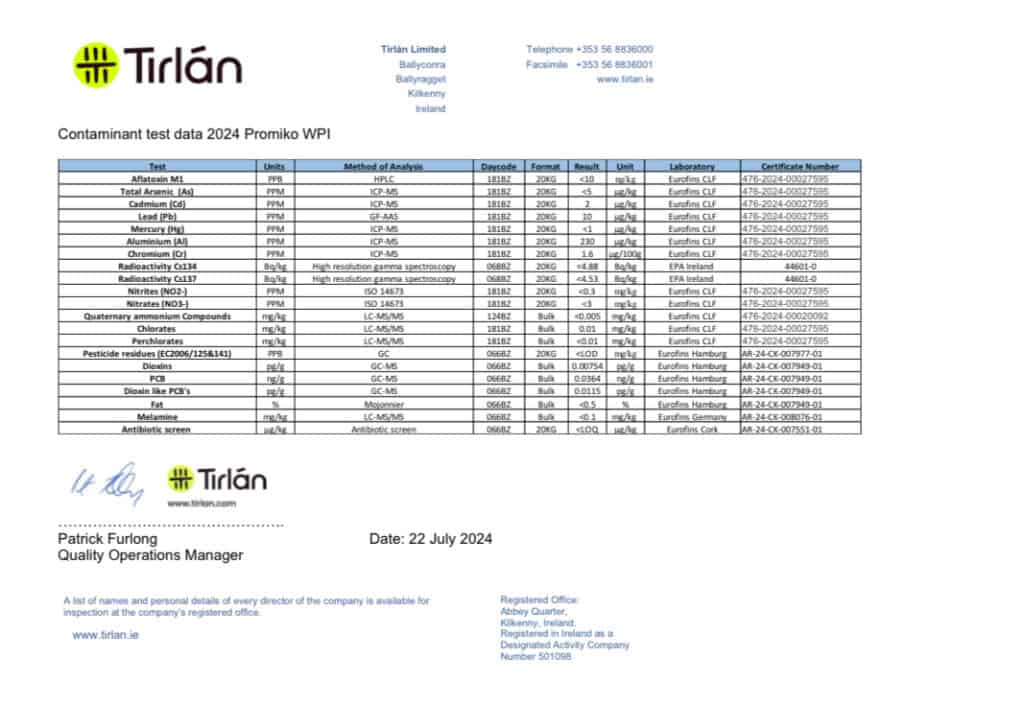
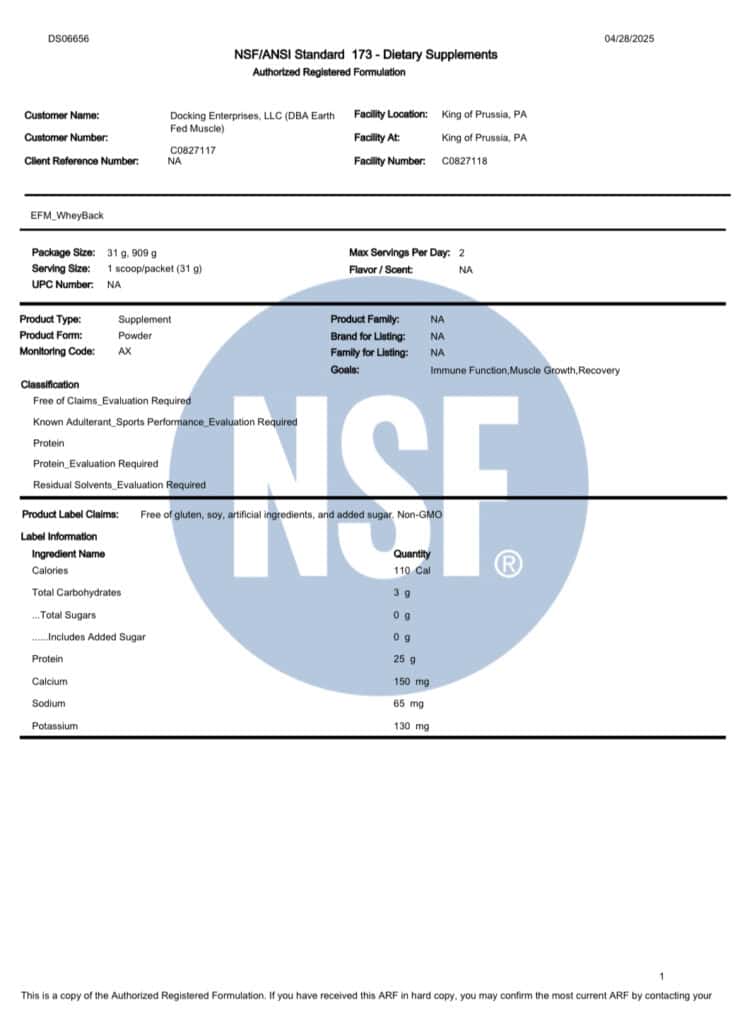
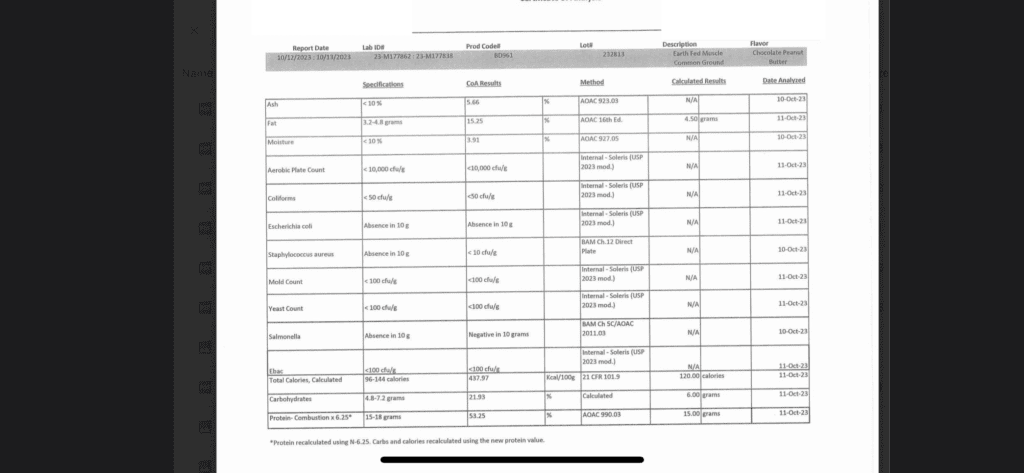
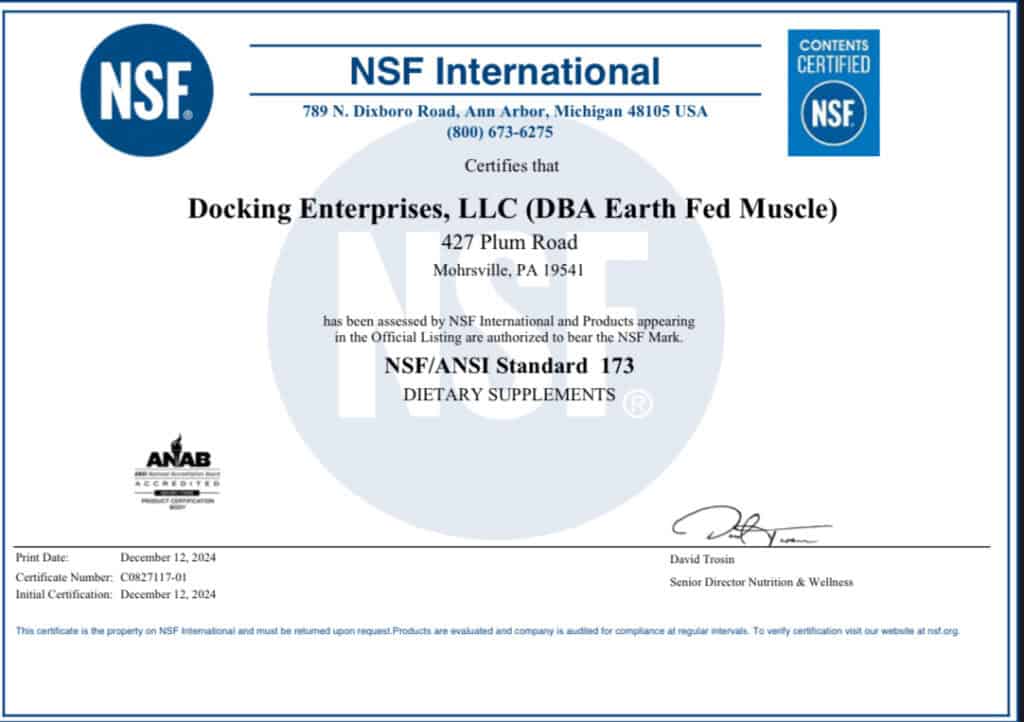
What isn’t certified (yet)
- The “organic” claim lacks a named certifier on-pack or page. In my reviews of Truvani Plant-Based Protein and Sunwarrior Classic Plus, the brands state “Certified Organic by ____” on the label. Earth Fed Muscle Organic Plant Protein should do the same.
- The posted amino table is manufacturer-supplied, not independently certified; COAs typically cover macros/microbials/metals—not an HPLC amino assay. For precision programming around muscle protein synthesis (MPS), ask for a lot-matched amino assay.
Status update: I contacted EFM regarding the organic certifier; response pending, and this Earth Fed Muscle Organic Plant Protein review will be updated when received.
Bottom line: Earth Fed Muscle Organic Plant Protein checks the big safety boxes (NSF, COAs, metals). To close the loop, EFM should publish the organic certifier and an independently verified amino profile.
⚠️ Common Ground Protein & Prop 65: What Earth Fed Muscle Tests—and What It Means
Answer: As of publication, Common Ground Protein (Earth Fed Muscle Organic Plant Protein) does not carry a Prop 65 warning. A different SKU—Earth Fed Muscle Nocturnal—does include a Prop 65 warning on its product page and on Amazon. That distinction matters for Common Ground Protein buyers who want safety first and drama never.
What EFM tests (and how they apply to Common Ground Protein):
- Lot + ingredient controls. “We test every batch of products for biological adulterants and macros… We test each production lot and can provide a certificate of analysis upon request.” Ingredients are screened before blending; cocoa beans are picked for taste and low metals.
- Heavy-metal results. Recent reports come in well below Prop 65 safe-harbor limits—often < 1/3 and frequently ~1/100 of the limit.
- Third-party signal. Brand holds NSF/ANSI 173 (dietary supplements); a toxicology report (Tirlan) was provided alongside COAs.
How to verify your tub of Common Ground Protein: Match the lot number on the bottom of the container and request the COA from support. Flavor details and the complete amino acid profile live on the Common Ground Chocolate product page. For label context, see the list of brands with a Prop 65 Warning.
Bottom line: Common Ground Protein sits under conservative screening (ingredient-level checks, lot COAs, outside toxicology) with clear disclosure if a warning is ever required. If your goal is to maintain a clean, Earth Fed Muscle Organic Plant Protein routine without guesswork, simply ask for the COA and keep lifting.
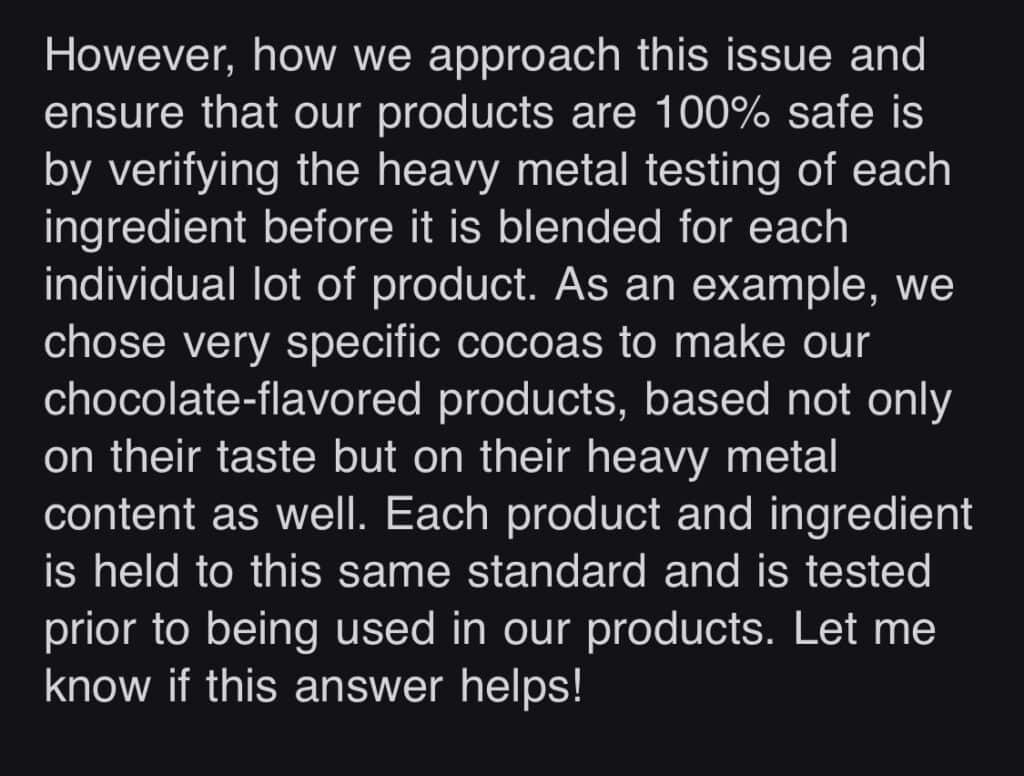
🔑 Plant-Based Protein Comparison: Earth Fed Muscle Vegan Protein Powder, TL;DR
This Earth Fed Muscle Protein review examines the amino acid profile, leucine per scoop, and the actual protein content after considering digestibility.
- Performance co-leads: Ritual & Transparent Labs — verification-first and efficient toward muscle protein synthesis (MPS); fewer scoops to target.
- Athlete-friendly base: Earth Fed Muscle Vegan Protein Powder — velvety mixability, complete amino acid profile, honest dose; plan servings to match goals.
- Meal-leaning option: Orgain — fuller scoop with more carbs/fiber; useful for satiety and weight-management playbooks.
- Greens/value pick: Vega — easy, convenient, and budget-friendly for general use.
Bottom Line: If performance per scoop is the brief, choose Ritual or Transparent Labs. For everyday shakes that actually taste good and mix quickly, Earth Fed Muscle Vegan Protein Powder is a great fit—just adjust the dosage to your training block. When fullness matters, Orgain works; for simple starts and price, Vega delivers. (And yes, Earth Fed Muscle Vegan Protein Powder stays the texture benchmark in this comparison.)
📊 Plant-Based Protein Comparison: Earth Fed Muscle Vegan Protein Powder
This section sets Earth Fed Muscle Vegan Protein Powder beside the brands readers ask about most: Ritual, Transparent Labs, Orgain, and Vega. The goal is practical clarity—complete amino acid profile, leucine per serving, percent protein per serving, third-party checks, and real-world use cases—so the table can do the math while the copy tells you who each one is for.
Earth Fed Muscle Vegan Protein Powder (Common Ground). Blended (pea + goji + hemp), shakes up velvety in cold water, and publishes an amino table—useful for amino acid transparency and day-to-day compliance. It’s the benchmark for flavor/mixability in this Earth Fed Muscle Vegan Protein Powder review.
Ritual. Single-source pea with documented third-party tested plant protein credentials and posted amino data. Chosen as the “control” because it pairs verification with lean macros and a clear protein yield per scoop—strong for muscle protein synthesis (MPS) with fewer scoops.
Transparent Labs. Pea + brown rice, higher dose per serving, and public COAs. Included because it combines larger servings of EAA-rich plant protein with rigorous verification—ideal for readers seeking both proof and performance in one package.
Orgain. Larger scoop, more carbs/fiber—positioned closer to a light meal. Selected for readers prioritizing fullness and weight-management routines where a shake often doubles as a snack.
Vega (Protein + Supergreens). General-use vegan protein powder, chocolate/vanilla with real greens. Supportive starting point for newcomers who want something easy, convenient, and consistent while building habits—then leveling up as goals sharpen.
Bottom line. The table details the numbers; this guide frames intent. If the priority is taste and ease of use, Earth Fed Muscle Vegan Protein Powder earns its spot. If verification and dosing efficiency are the key factors, see Ritual and Transparent Labs. For everyday satiety or greens-plus convenience, Orgain and Vega make sense.
🆚 Plant-Based Protein Comparison: Earth Fed Muscle vs Ritual
In Earth Fed Muscle vs. Ritual, it’s a craft blend versus a verification-first approach. Earth Fed Muscle leans organic-forward (pea, goji, hemp) and drinks light and velvety; Ritual is single-source pea with third-party validation and a tighter amino story. Let the table carry the arithmetic. The narrative is simple: Earth Fed Muscle vs Ritual weighs a smoothie-friendly profile against a formula built to reach training thresholds with fewer scoops.
Formulation is the split. Hemp and flavor load can dilute the active protein in the EFM blend, whereas Ritual maintains a minimalist split that supports higher effective protein and leucine per serving. Daily macros sit close; the practical gap comes from how fast each scoop moves the MPS needle. Certifications and specs are published for Ritual Protein Powder (Amazon affiliate). A Ritual tub was purchased on Amazon; a standalone review is forthcoming, but the comparison table below does the heavy lifting for Earth Fed Muscle vs Ritual readers.
In day-to-day use, Earth Fed Muscle vs Ritual becomes a style decision: texture-first ease and budget on one side, documented potency on the other.
| Earth Fed Muscle vs Ritual: Key Differences & Comparison Metrics | ||||
| Key Differences & Comparison Metrics | Earth Fed Muscle Common Ground Chocolate | %DV | Ritual Protein Powder Chocolate | %DV |
| Leucine | 1.187g | 1.785g(Informed Protein Verified) | ||
| Leucine Percent | 9.89% | 10.5% | ||
| Total BCAAs | 2.664g | 3.972g | ||
| Protein per Serving | 15g | 30% | 20g | 33% |
| Actual Protein per Serving | 12g | 17g | ||
| Carbs per Serving | 5g | 2% | 3g | 1% |
| Fiber per Serving | 3g | 11% | 2g | 7% |
| Total Sugars | 0g | — | 0g | — |
| Calories | 110 kcal | 120 kcal | ||
| Serving Size | 26g | 31g | ||
| Number of Servings | 30 | 15 | ||
| Amazon Price(September 2025) | $59.99 | $48.99 | ||
| Price per Serving | $2.00 | $3.27 | ||
Bottom Line: For athletes targeting an MPS-level dose with fewer scoops and wanting independent verification, Ritual is the stronger pick—higher leucine per serving, higher effective protein, proof to match. Earth Fed Muscle Common Ground remains a pleasant, blended option at a lower price per serving; matching Ritual’s recovery pace typically means a larger pour or a leucine top-off.
🆚 Plant-Based Protein Comparison: Earth Fed Muscle vs Transparent Labs
In Earth Fed Muscle vs Transparent Labs, it’s smoothie-friendly craft versus proof-first performance. Earth Fed Muscle Common Ground leans organic-forward (pea, goji, hemp) with a light, velvety sip that disappears in a shaker. Transparent Labs Plant Protein answers with a denser pea + brown rice dose built around third-party verification and lot transparency. The table carries the math; this section carries the feel.
Here’s the cadence. In Earth Fed Muscle vs Transparent Labs, Common Ground suits quick, low-calorie routines and daily smoothies, while TL feels tuned for training blocks—more protein per scoop, more amino support, fewer scoops to move the MPS needle. Common Ground’s flavor load and hemp fraction make it easy to drink; TL’s verification and pea-rice pairing make it easy to trust. (A review tub of TL was purchased directly from the company; full review forthcoming.)
What the chart clarifies is that Earth Fed Muscle vs. Transparent Labs makes practical sense: one is built for effortless compliance, while the other is designed for efficient dosing. Both have their lane; the decision is whether the priority is texture and simplicity or confirmation and output.
| Earth Fed Muscle vs Transparent Labs: Key Differences & Comparison Metrics | ||||
| Key Differences & Comparison Metrics | Earth Fed Muscle Common Ground Chocolate | %DV | Transparent Labs Plant Protein Chocolate | %DV |
| Leucine | 1.187g | 2.15g(Informed Protein Verified) | ||
| Leucine Percent | 9.89% | 12.64% | ||
| Total BCAAs | 2.664g | 4.82g | ||
| Protein per Serving | 15g | 30% | 24g | 33% |
| Actual Protein per Serving | 12g | 17g | ||
| Carbs per Serving | 5g | 2% | 6g | 2% |
| Fiber per Serving | 3g | 11% | 3g | 11% |
| Total Sugars | 0g | — | 2g | — |
| Calories | 110 kcal | 140 kcal | ||
| Serving Size | 26g | 37g | ||
| Number of Servings | 30 | 30 | ||
| Amazon Price(September 2025) | $59.99 | $59.99(Not Available at Amazon) | ||
| Price per Serving | $2.00 | $2.00 | ||
Earth Fed Muscle vs Transparent Labs: Bottom Line. For athletes seeking muscle protein synthesis with fewer scoops and documented integrity, Transparent Labs stands out—offering higher amino support, stronger %DV logic, and third-party validation at the same price per serving. Earth Fed Muscle Common Ground remains a polished, blended option for general wellness and shake-friendly routines—just plan on a larger pour or a leucine top-off to match TL’s recovery dose.
🆚 Plant-Based Protein Comparison: Earth Fed Muscle vs Vega
In Earth Fed Muscle vs Vega, it’s a performance blend versus a protein-plus-greens formula. Earth Fed Muscle Common Ground (Chocolate) drinks light and velvety, the kind of chocolate that disappears in cold water and still reads grown-up. Vega Protein + Supergreens (Vanilla) plays the everyday, pantry-ready role—greens, stevia, broad retail access, and a friendlier price tag.
Let the table do the math. The story is cadence. In Earth Fed Muscle vs Vega, Common Ground offers more actual protein per serving and more fiber in a smaller scoop, along with higher leucine and BCAA figures that support lean performance. Vega offers convenience and value, along with the greens angle, but its PDCAAS-adjusted protein and amino figures trend lighter per serving in this matchup. Specs and availability for Vega live here: Vega Protein + Supergreens (Vanilla) on Amazon. A review copy was purchased directly from Amazon; a full brand review is planned.
Practically, Earth Fed Muscle vs Vega reads as sleek and nimble versus hearty and economical. One suits training blocks and shaker-cup efficiency; the other aims at daily nutrition with a gentler dose.
| Earth Fed Muscle vs Vega: Key Differences & Comparison Metrics | ||||
| Key Differences & Comparison Metrics | Earth Fed Muscle Common Ground Chocolate | %DV | Vega Protein + Super Greens, Plant-Based Protein Vanilla | %DV |
| Leucine | 1.187g | .89g | ||
| Leucine Percent | 9.89% | 6.36% | ||
| Total BCAAs | 2.664g | 1.86g | ||
| Protein per Serving | 15g | 30% | 20g | 27% |
| Actual Protein per Serving | 12g | 14g | ||
| Carbs per Serving | 5g | 2% | 5g | 2% |
| Fiber per Serving | 3g | 11% | 1g | 4% |
| Total Sugars | 0g | — | 1g | — |
| Calories | 110 kcal | 120 kcal | ||
| Serving Size | 26g | 30g | ||
| Number of Servings | 30 | 25 | ||
| Amazon Price(September 2025) | $59.99 | $31.61 | ||
| Price per Serving | $2.00 | $1.26 | ||
Final thoughts on Earth Fed Muscle vs Vega: For athletes prioritizing dose efficiency and stronger amino support in a lean shake, Earth Fed Muscle takes the edge. For a budget and a greens-included daily driver, Vega wins on price and convenience. In short, Earth Fed Muscle vs Vega is efficiency versus economy—pick by goal, not hype.
🆚 Plant-Based Protein Comparison: Earth Fed Muscle vs Orgain Protein
Earth Fed Muscle vs Orgain Protein reads like lean shaker versus mini-meal. Earth Fed Muscle Common Ground drinks light and velvety—easy in cold water, cocoa-forward, the kind of chocolate that actually disappears into a morning routine. Orgain Plant Protein comes in a heartier package: thicker body, fuller glass, pantry-staple energy.
Both brands post a complete amino acid profile; the chart displays the percentage of protein per serving and the amount of leucine per serving. What matters in Earth Fed Muscle vs Orgain Protein is cadence: Common Ground suits quick, low-calorie sips and smoothie add-ins; Orgain feels built for a bigger pour when a shake doubles as a snack.
Formulation intent differs, too. Earth Fed Muscle vs Orgain Protein pits a blended profile (pea + goji + hemp) against Orgain’s larger, smoothie-like serving with disclosed BCAAs. For availability and specs, see Orgain Plant Protein on Amazon. A review container was purchased directly from Amazon; a full review of Orgain is planned.
In day-to-day use, Earth Fed Muscle vs Orgain Protein becomes a style choice: sleek and nimble (EFM) or hearty and practical (Orgain). The palate will pick the winner; the table below keeps the score.
| Earth Fed Muscle vs Orgain Protein: Key Differences & Comparison Metrics | ||||
| Key Differences & Comparison Metrics | Earth Fed Muscle Common Ground Chocolate | %DV | Orgain Plant Protein | %DV |
| Leucine | 1.187g | 1.770g | ||
| Leucine Percent | 9.89% | 11.06% | ||
| Total BCAAs | 2.664g | 3.987% | ||
| Protein per Serving | 15g | 30% | 21g | 32% |
| Actual Protein per Serving | 12g | 16g | ||
| Carbs per Serving | 5g | 2% | 15g | 5% |
| Fiber per Serving | 3g | 11% | 4g | 14% |
| Total Sugars | 0g | — | <1g | — |
| Calories | 110 kcal | 150 kcal | ||
| Serving Size | 26g | 46g | ||
| Number of Servings | 30 | 20 | ||
| Amazon Price(September 2025) | $59.99 | $30.98 | ||
| Price per Serving | $2.00 | $1.55 | ||
Bottom Line: Earth Fed Muscle vs Orgain Protein – For dose efficiency and value, Orgain takes the lead: more protein and leucine per serving at a lower cost, shortening the path to an MPS-level dose. Earth Fed Muscle Common Ground fits the leaner-macro lane—great as a lighter base—though matching Orgain’s recovery dose typically requires a larger pour or a leucine top-off.
⭐️ Amazon Whey Protein Review: Earth Fed Muscle Reviews
Snapshot: 31 total Amazon reviews, 4.4/5 average. Small sample, clear signal—and two quotes below are Amazon Vine (disclosure). This section consolidates the most useful takeaways for Earth Fed Muscle Reviews readers.
5-Star fan club (direct quotes, lightly trimmed):
- “My absolute favorite!… blends seamlessly!… My favorite!!”
- “…perfect choice—and it didn’t disappoint… the powder blends easily… flavor balance is excellent—solid chocolate… cleaner, tastier… The only minor downside is 15g protein… well worth it.”
- “Fantastically made… DELICIOUS… blends fairly easily… plant-based… doesn’t contain gluten or soy… uses pea protein instead.” — Amazon Vine
1-Star buyer’s remorse (direct quote):
- “Not a pleasant experience… very gritty… odd green-ish taste… way too much sweetness… the finish is extremely unpleasant… just gross.” — Amazon Vine
What it means (consistent with prior Earth Fed Muscle Reviews): Mixability is a standout: cold water + shaker, no clumps, no sludge, a velvety body that reads above typical plant powders. Chocolate flavor lands as real cocoa with stevia kept in check—unusual in this category and echoed across Earth Fed Muscle Reviews.
Caveats worth tracking:
- The placement of natural flavors varies by flavor; Chocolate Peanut Butter lists it near the end but also shows the lowest leucine content per serving among the three—note for dosing.
- Silica (silicon dioxide) likely contributes to that ultra-clean shake-up (flagged here for transparency).
- “Organic”: no certifying agency listed on the container; the brand has been contacted, and a reply is pending.
Bottom line for Earth Fed Muscle Reviews: excellent mixability and chocolate execution drive satisfaction; labeling/verification questions (natural flavors placement, silica, organic certifier, leucine variance by flavor) remain on the follow-up list.
Summary
Earth Fed Muscle Protein Review: Tastes Great, But Does the Label Hold Up?
In this Earth Fed Muscle Protein review, you’ll find a shake that nails flavor and mixability but stumbles on transparency. The label boasts 15 g of protein, yet digestibility math drops it closer to 10–12 g usable. Natural flavors rank high in Chocolate and Vanilla, which raises questions when the brand leans so heavily on purity marketing. Still, Chocolate Peanut Butter strikes a balance between flavor and density. This Earth Fed Muscle Protein review indicates it is effective for casual users, but not for athletes seeking precise muscle protein synthesis. Consider this Earth Fed Muscle Protein review your shortcut to deciding if taste outweighs proof.
Pros
- Excellent chocolate flavor and smooth mixability
- Soy-free, gluten-free, no artificial sweeteners
- NSF listed and lot-tested for safety
Cons
- “15 g” per scoop translates to closer to 10–12 g usable protein once digestibility is factored in.
- “Organic” claim lacks a USDA seal or certifier
- Natural flavors sit high on the ingredient panel in Chocolate and Vanilla
- Amino acid profile is manufacturer-supplied with no third-party verification
- $60 per tub feels steep without verified sourcing or certifications
🥤 How to Mix Earth Fed Muscle Protein Powder
Label directions are simple: 1 scoop with 6–12 oz of nut milk, seed milk, or water; 1 scoop in the morning and one scoop post-workout. For the Common Ground Plant Protein Review, that’s the baseline. Now the useful part—how it actually mixes, and whether a single scoop supports muscle protein synthesis (MPS).
Mixability: shockingly good. Most chocolate vegan protein powders turn grainy unless they’re blitzed in a blender. This chocolate pea protein didn’t blink. Cold water + shaker = no clumps, no sludge, no hassle. That performance aligns with the product’s texture system and explains why the Common Ground Plant Protein Review recommends a plain shaker for on-the-go use.
Dose reality: the brand suggests one scoop after training. The math says otherwise. With the published leucine per serving, one scoop falls short of the common 2.5–3.0 g leucine target for peak MPS. In practice, expect two scoops post-workout.
A note on silica: the ingredient deck includes silicon dioxide (silica), a common anti-caking agent that improves flow and shake-up—likely why the texture is a home run. It can appear in organic-positioned formulas; some readers still raise an eyebrow, much like seeing a Prop 65 warning on supplements. The Common Ground Plant Protein Review views this as a transparency footnote, rather than a deal-breaker.
Bottom line for mixing: outstanding mixability, clean finish, and consistent texture in water. For outcomes, tie the serving size to the goal: one scoop for a light snack; a larger dose when protein yield per scoop, percent protein per serving, and MPS actually matter in training blocks.
⚖️ Common Ground Scoop Size
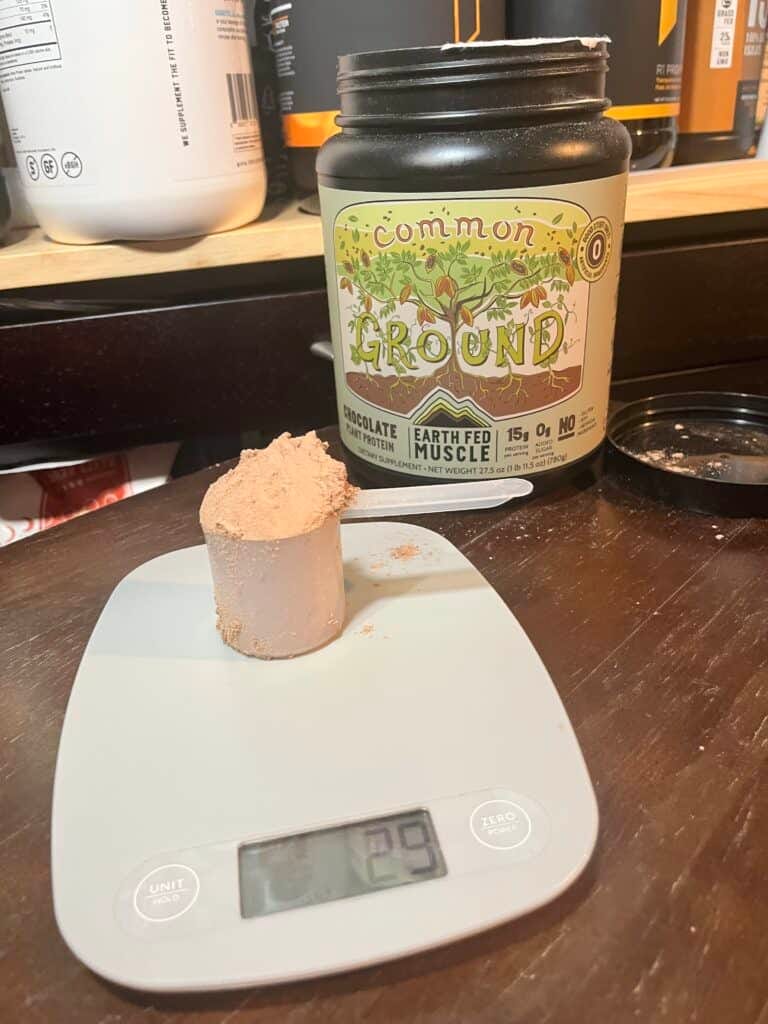
👌 Common Ground Chocolate: Earth Fed Muscle Best Flavor?
The label whispers “chocolate plant protein.” The tub is cocoa-tree brown. The question is simple: Does it drink like chocolate? In this Earth Fed Muscle Pea Protein taste test, it does—cleanly and without the usual grit.
First, the body. Think velvety, not sandy. Unlike most chocolate vegan protein powders, which require a blender to dissolve, this one dissolves instantly in cold water with a shaker. No sludge, no foam beard. The cocoa lands up front, warm and rounded, with just enough bitterness to feel real. Sweetness is stevia—normally a deal-breaker for me (see my diary-based Earth Fed Muscle review)—but here it stays in the pocket. No metallic medicinal aftertaste.
Secondly, the “pea” question. Many blends advertise vegan protein powder and chocolate, yet they still taste like peas. Earth Fed Muscle Pea Protein sidesteps that. Blindfolded beside a basic whey, this chocolate could pass. That matters for everyday compliance: if a shake tastes like dessert, it gets used.
Verdict: Chocolate is the standout flavor in this line—balanced cocoa, smooth finish, and zero “pea” reminder. For the Common Ground Plant Protein Review, it’s the flavor that occasionally becomes an everyday staple. As a daily driver, Earth Fed Muscle Pea Protein in chocolate is a reliable “gateway” pick for athletes and skeptics alike.
Mixability: 10 out of 10.
Earth Fed Muscle Pea Protein mixed like a pro—cold water & shaker, no clumps, no sludge, no drama—mixability is amazing. And the texture home run: velvety body instead of the usual plant grit. Flavor is amazing for a plant-protein, plus no pea reminder; in a blind pour, it could pass for whey.
🔑 Earth Fed Muscle Plant Protein Ingredients, TL;DR
Earth Fed Muscle Protein Powder looks clean at first glance—pea, hemp, and goji build the plant protein base, while cocoa, salt, and stevia handle flavor. It’s free from soy, gluten, and artificial sweeteners, and that’s a win in a market full of junk fillers. The simplicity feels honest, but once you dig deeper, cracks appear.
The label screams “Organic,” yet there’s no USDA Organic seal, no disclosed certifier, and no sourcing transparency. Silica appears under both “silica” and “silicon dioxide,” which are technically the same FDA-approved anti-caking agent, but the inconsistency feels sloppy for a premium $60 tub. And “natural flavors” still sit behind the FDA’s umbrella term, leaving buyers in the dark about what’s actually inside.
Bottom Line: Earth Fed Muscle Protein Powder earns points for keeping its formula short and adhering to its advertised claims: no soy, gluten, or artificial additives. However, without organic verification, vague natural flavor disclosures, and small inconsistencies across flavors, the ingredient list doesn’t fully support the premium marketing story. Transparency—not just taste—should be the standard here.
📋 Earth Fed Muscle Plant Protein Ingredients
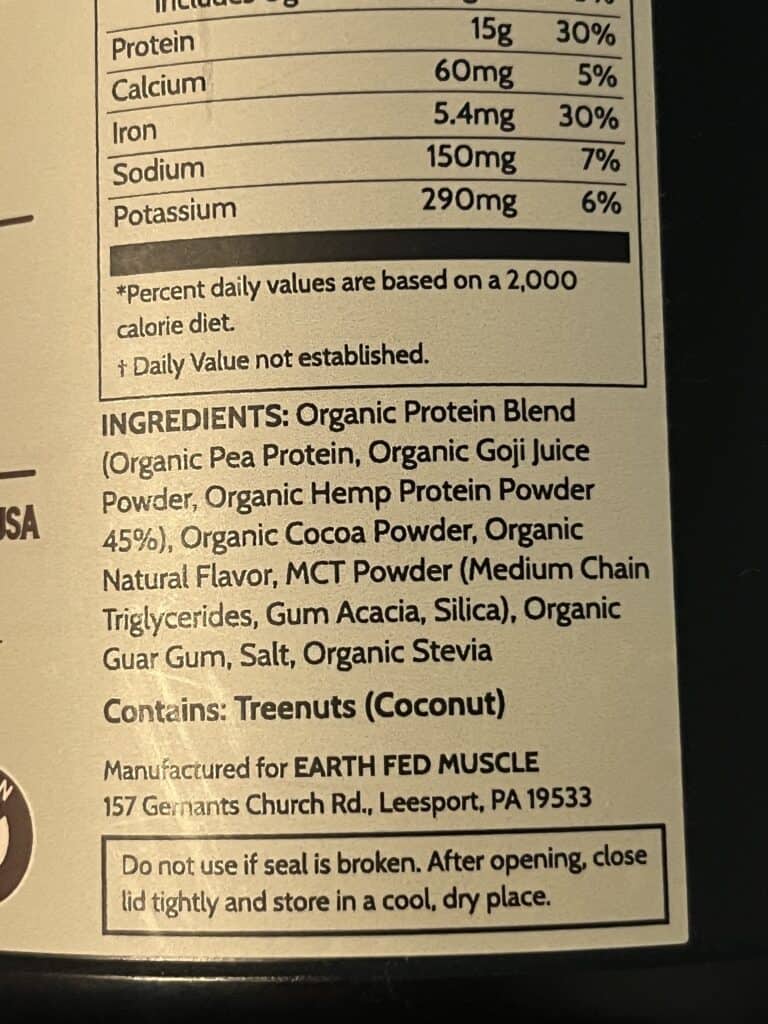
Earth Fed Muscle Plant Protein keeps its ingredient list short, clean, and recognizable. Pea, hemp, and goji supply the protein base, while cocoa and natural flavors round out the taste. Buyers get what they expect: no gluten, soy, or artificial sweeteners—a legitimate strength in the crowded vegan protein category.
But here’s where the marketing shine, dulls. Common Ground prints “Organic” across the panel, yet there’s no USDA Organic seal or disclosed certifier. When pressed, the company declined to share who verifies its sourcing. For a $60 tub, that lack of third-party validation is a letdown compared to peers that back their organic claim with a certifying body.
Silica also deserves a note. In Chocolate and Vanilla, it’s listed as “silica,” while Chocolate Peanut Butter uses “silicon dioxide.” They’re functionally the same anti-caking agent—FDA permits silicon dioxide as a direct food additive and categorizes it as “Generally Recognized as Safe” (GRAS), as long as it doesn’t exceed 2% of the product’s weight (FDA, 21 CFR §172.480). Scientific panels agree: “No carcinogenic effects were reported from chronic feeding studies at the highest doses tested of 7,500 mg silica gel/kg bw per day in mice” (EFSA Panel, 2018). English: safe, functional, but nutritionally empty.
That’s why the inconsistency matters. FDA classifies both terms as safe, but neither adds nutritional value, and long-term health effects at dietary levels aren’t flagged in the literature (PMC Review, 2020). Still, bouncing between “silica” and “silicon dioxide” feels sloppy for a brand trading on purity.
Earth Fed Muscle Plant Protein’s ingredient list supports the company’s soy-free, gluten-free, and no-artificial-ingredients claims—but the absence of organic certification, unclear natural flavor details, and vague labeling should raise concerns for buyers.
| Common Ground Chocolate Protein Ingredient List | |
| Ingredient | Purpose |
| Organic Protein Blend | |
| -Organic Pea Protein | The core protein source provides the main bulk of the 15g of protein |
| -Organic Goji Juice Powder | Superfood that is an anti-inflammatory, high in fiber |
| -Organic Hemp Protein Powder 45% | Secondary plant protein source; boosts omega-3/6 fatty acids and fiber, though lower in digestibility (PDCAAS <0.7) |
| Organic Cocoa Powder | Flavor |
| Organic Natural Flavor | A broad FDA category (21 CFR 101.22) is used to standardize flavor. Can mask the earthiness of hemp/pea base. Lacks transparency. |
| MCT Powder | |
| -Medium Chain Triglycerides | Adds fats for creaminess |
| -Gum Acacia | A stabilizing fiber used to turn MCT oil into powder form |
| -Silica | Prevents clumping |
| Organic Guar Gum | Thickener and stabilizer; improves texture and mixability in plant proteins |
| Salt | Flavoring |
| Stevia | Zero-calorie natural sweetener |
🌍 Does EFM Plant Protein Use USA-Sourced Ingredients?
Earth Fed Muscle Plant Protein wears the “clean” badge with pride, but when you peel back the sourcing story, the trail goes cold. The brand does provide a certificate of analysis (CoA) for all three flavors, which is more than some competitors ever show. The catch? Those CoAs verify testing data—not where the ingredients come from. There’s no origin disclosure for the pea, hemp, or goji base.
Normally, plant proteins at this price point flag origin—European pea isolate, Canadian hemp, or USDA Organic certification to anchor trust. Here, we get none of that. Just as noticeable: the label doesn’t carry the standard “Made in the USA with domestic and international ingredients” disclaimer you’ll often find on supplements. For a brand selling at $60 a tub, the absence of sourcing transparency feels like a hole in the story.
On the flipside, I’m not calling this a deal-breaker. Earth Fed Muscle Plant Protein still avoids the usual red flags: no artificial sweeteners, no soy, no gluten, and a clean CoA proving baseline quality. But if you want country-of-origin assurance or a verified organic badge, this isn’t where you’ll find it.
Ingredients List: 8.0 out of 10.
Earth Fed Muscle Plant Protein makes a strong first impression with its short, recognizable ingredient list—pea, hemp, and goji at the core, cocoa and stevia for flavor, and no soy, gluten, or artificial additives. The “Organic” claim, however, is where the story gets softer: no USDA seal, no certifier, and no sourcing disclosure. Silicon dioxide (listed inconsistently as “silica” in some flavors) is FDA-recognized as safe at dietary levels, with no Prop 65 red flags. Still, it adds no nutritional value and undercuts the brand’s purity-first image. Transparency is the real gap—while the list itself looks clean, the lack of verified certifications and ingredient origin leaves buyers with more trust in the marketing than in documented sourcing.
🔑 Earth Fed Muscle Plant Protein Nutrition Facts, TL;DR
At a glance, the panel on Earth Fed Muscle Protein Powder looks clean: 110 calories, low fat, and 15 g of protein per scoop. But the math doesn’t quite square up. Pea and hemp don’t digest like whey—so that “15 g” printed in bold is really closer to 10–12 g of usable protein, depending on the flavor. Fiber (3 g), minerals, and zero sugar are all strengths, but protein density averages just 43%. That gap between label math and body math is the catch.
The odd part is transparency. Chocolate flavors list cocoa and then tack on “natural flavors.” Vanilla goes further—“natural flavors” lands second on the panel, heavier than you’d expect if transparency were the goal. Chocolate Peanut Butter keeps “natural flavors” fifth, making it the most legitimate of the lineup. None of this screams amino spiking, but the label leans hard on FDA code flexibility.
Bottom Line: Earth Fed Muscle Protein Powder offers a straightforward vegan shake with a concise ingredient list, but its effective protein yield falls short on the listed Supplement Facts panel.

🥗 Earth Fed Muscle Plant Protein Nutrition Facts
At first glance, the nutrition facts for Earth Fed Muscle Protein look standard—110 calories, low fat, and a respectable 15 g of protein. But peel back the numbers, and the math doesn’t quite add up. Pea and hemp don’t digest like whey: once you factor in protein quality and digestibility, that 15 g serving lands closer to 10–12 g of usable protein, depending on the flavor. In other words, the label math and the body math tell two different stories.
The rest of the panel is straightforward—3 g of fiber, 0 g sugar, modest minerals. Nothing alarming here. The Earth Fed Muscle Protein label appears to be clean on calories and macros, but when it comes to protein yield, the math doesn’t add up. Count grams by digestibility, not just what’s printed on the tub.
| Common Ground Chocolate Protein: Full Nutrition Breakdown | ||
| Nutrients | Amount per Serving (26g) | % Daily Value (%DV) |
| Calories | 110 kcal | — |
| Total Fat | 3g | 4% |
| Sodium (mg) | 150mg | 7% |
| Total Carbohydrates (g) | 5g | 2% |
| Dietary Fiber (g) | 3g | 11% |
| Total Sugars (g) | 0g | — |
| ListedProtein (g) | 15g | 30% |
| Leucine | 1.187g | — |
| Total BCAAs | 2.664g | — |
| Calcium | 60mg | 5% |
| Iron | 5.4mg | 30% |
| Potassium | 290mg | 6% |
🍗 Protein Percentage per Serving in Earth Fed Muscle Plant Protein
On paper, Earth Fed Muscle prints 13–15 g of protein per serving across its Common Ground flavors. Do the math against scoop size and %DV, and the reality settles closer to 10–12 g usable protein—a protein density averaging ~43%. That’s not amino spiking in the classic sense (no telltale nitrogen fillers like glycine or creatine).
The oddest piece is flavor placement. In Chocolate, you get cocoa powder followed immediately by “natural flavors”—essentially chocolate on chocolate. Vanilla is even murkier: “natural flavors” lands second, heavier on the panel than most buyers would expect, when transparency could be as simple as “Madagascar vanilla.” The FDA allows brands to keep “natural flavors” behind a regulatory curtain (21 CFR 101.22), meaning we don’t know if any amino-containing components fall under that umbrella. That’s not evidence of nitrogen inflation, but it leaves a crack wide enough for suspicion.
By contrast, Chocolate Peanut Butter lists “natural flavors” fifth, after the proteins and emulsifiers. That lighter flavor load aligns better with its 42% protein density and makes it the most legitimate pick of the lineup for buyers chasing actual protein yield, not just panel polish.
Bottom line: Earth Fed Muscle delivers real plant protein, but flavor-panel opacity and density gaps leave the math less reassuring than the glossy “15 g” headline suggests.
| Earth Fed Muscle Flavors | Protein per Serving (g) | Protein %DV | Actual Protein per Serving Based on %DV | Scoop Size (g) | Protein Percentage (%) |
| Chocolate | 15g | 30% | 12g | 26g | 46% |
| Vanilla | 13g | 26% | 10g | 24g | 41% |
| Chocolate Peanut Butter | 15g | 30% | 12g | 28g | 42% |
| Average Protein Percent Across All Earth Fed Muscle Flavors: 43% | |||||
Nutrition Facts: 4.0 out of 10.
The Earth Fed Muscle Plant-Based Protein label is the first plant powder I’ve reviewed that actually prints the full serving claim—15 g on paper. However, running the PDCAAS math results in a number that drops to 10–12 g of usable protein, depending on the flavor. The problem isn’t that they ignored PDCAAS; it’s that they leaned on the flexibility of the Supplement Facts format to make the label look cleaner than the science supports. That gap—between optimistic label math and digestibility reality—is paired with a protein density that averages just 43%.
📋 Earth Fed Muscle Plant Protein Review FAQ
Earth Fed Muscle is privately owned and operated by its founding team. The company was co-founded by Chris Stamm, who mixed the very first batch of clean chocolate whey in his kitchen and now serves as COO and chief formulator. The CEO is Brooks Miller, who brings a background in agriculture and sustainable farming to the brand.
Leadership also includes Tyler Dunkelberger (CFO) and Sara Williams (Marketing Director), alongside a small, visible team that runs operations, sales, and customer service.
As their official Meet the Team page highlights, Earth Fed Muscle isn’t a faceless supplement giant—it’s a Pennsylvania-based, founder-led company with roots in strength sports, sustainable farming, and small-batch quality.
The return policy lists their address as 303 Caramist Circle, Sinking Spring, PA 19608. That’s where Earth Fed Muscle Protein is shipped back for refunds or exchanges, confirming U.S. operations. Although the company is U.S.-based, the origin of the ingredients is not disclosed, leaving buyers uncertain whether pea, hemp, or goji are domestic or imported.
Yes—for safety and quality. The Earth Fed Muscle Protein review shows lot-level COAs, NSF/ANSI 173 listing, and heavy-metal screening. What isn’t verified is the amino acid profile, which is manufacturer-supplied.
It depends on what you want. If your priority is mixability and flavor, Earth Fed Muscle Plant Protein delivers a velvety, grit-free shake. But if your priority is protein density or verified amino transparency, the review found gaps—usable protein averages closer to 10–12 g, not the 15 g on the label.
Yes. The Earth Fed Muscle Protein review confirms the brand is NSF/ANSI 173 listed under dietary supplements, which is a legitimate quality and safety certification.
Earth Fed Muscle comes across as a clean-label, U.S.-based company with strong safety testing and great flavor execution. However, the absence of a USDA Organic seal, unclear ingredient origins, and lack of third-party amino verification prevent it from being considered a transparency-first brand.
For Common Ground Protein Powder, heavy-metal screening reports were provided and came in well below Prop 65 safe-harbor limits. No Prop 65 warning is required for this product.
Yes. The label and Earth Fed Muscle Protein review confirm it is free from soy, gluten, and artificial ingredients.
Each scoop of Earth Fed Muscle Protein Powder lists 110 calories, with 3 g fat, 5 g carbs (3 g fiber), and 15 g protein on paper.
No hard evidence. The Earth Fed Muscle Protein review found no red-flag fillers like glycine or creatine. However, because amino numbers are manufacturer-supplied and “natural flavors” can legally mask unknowns, the transparency gap keeps this in the gray. The conclusion: not fraudulent, but not airtight either.
It can be, but not off a single scoop. Earth Fed Muscle Plant Protein lists 15 g per serving, yet digestibility math drops it closer to 10–12 g usable protein with ~1.1 g leucine. Since research shows you need ~2.5–3.0 g leucine per meal to stimulate muscle protein synthesis (MPS) maximally, you’ll need at least two scoops—or pair one scoop with leucine-rich foods like dairy or eggs—to hit the mark. Common Ground works as a daily vegan shake, but on its own, it’s underdosed for post-workout recovery.
Yes and no. Earth Fed Muscle Plant Protein (the Common Ground line) is fully vegan, built on pea, hemp, and goji. But the company also sells whey-based powders—so not every product fits a vegan diet. Always check the label: if it says “Common Ground Plant Protein,” it’s vegan-friendly; if it says “Whey Back” or “Collagen,” it’s not.
The tub says “organic,” but the Earth Fed Muscle Protein review flagged a problem: there’s no USDA Organic seal and no disclosed certifier. Without third-party validation, “organic” is more of a marketing phrase than a guarantee. For a $60 plant protein, that gap is a letdown compared to competitors who back their claims with a certifying agency.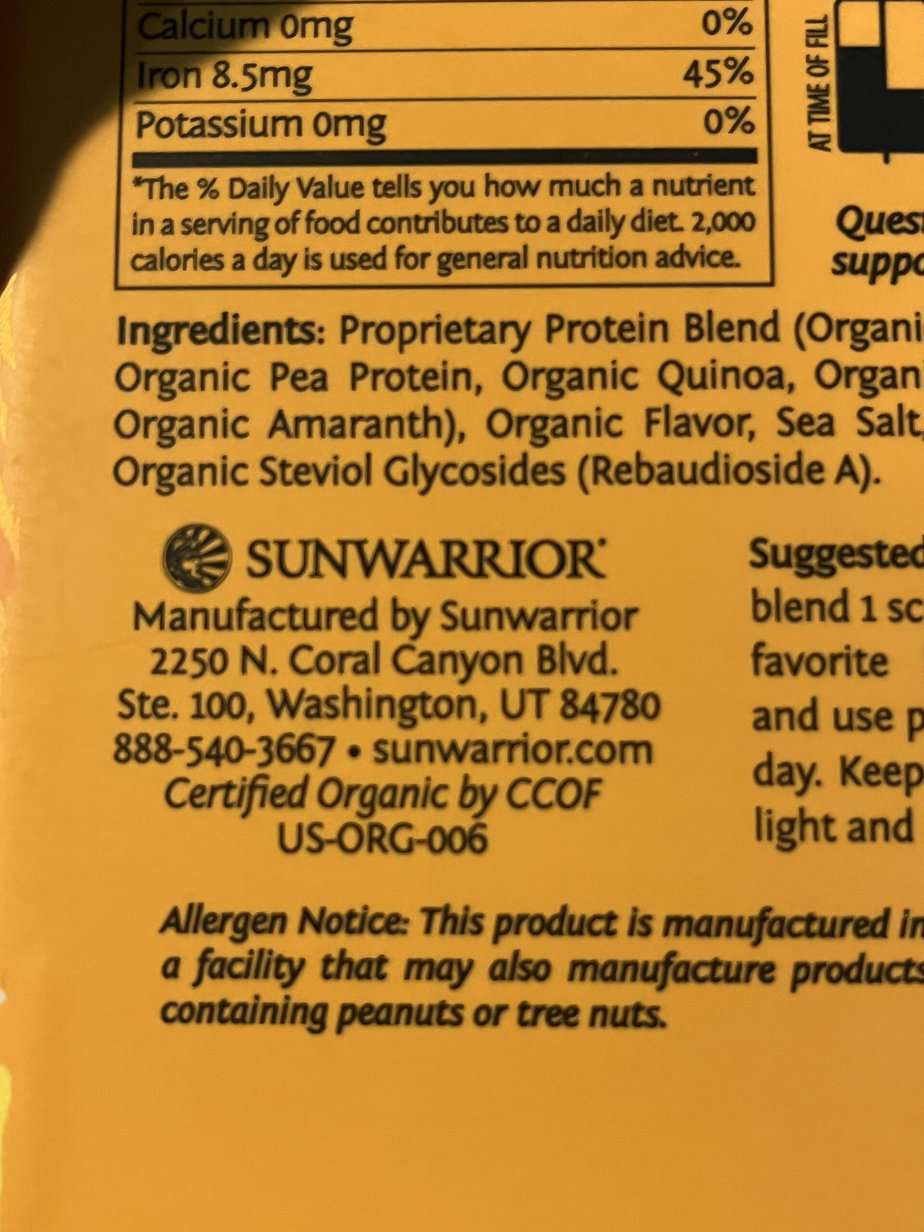
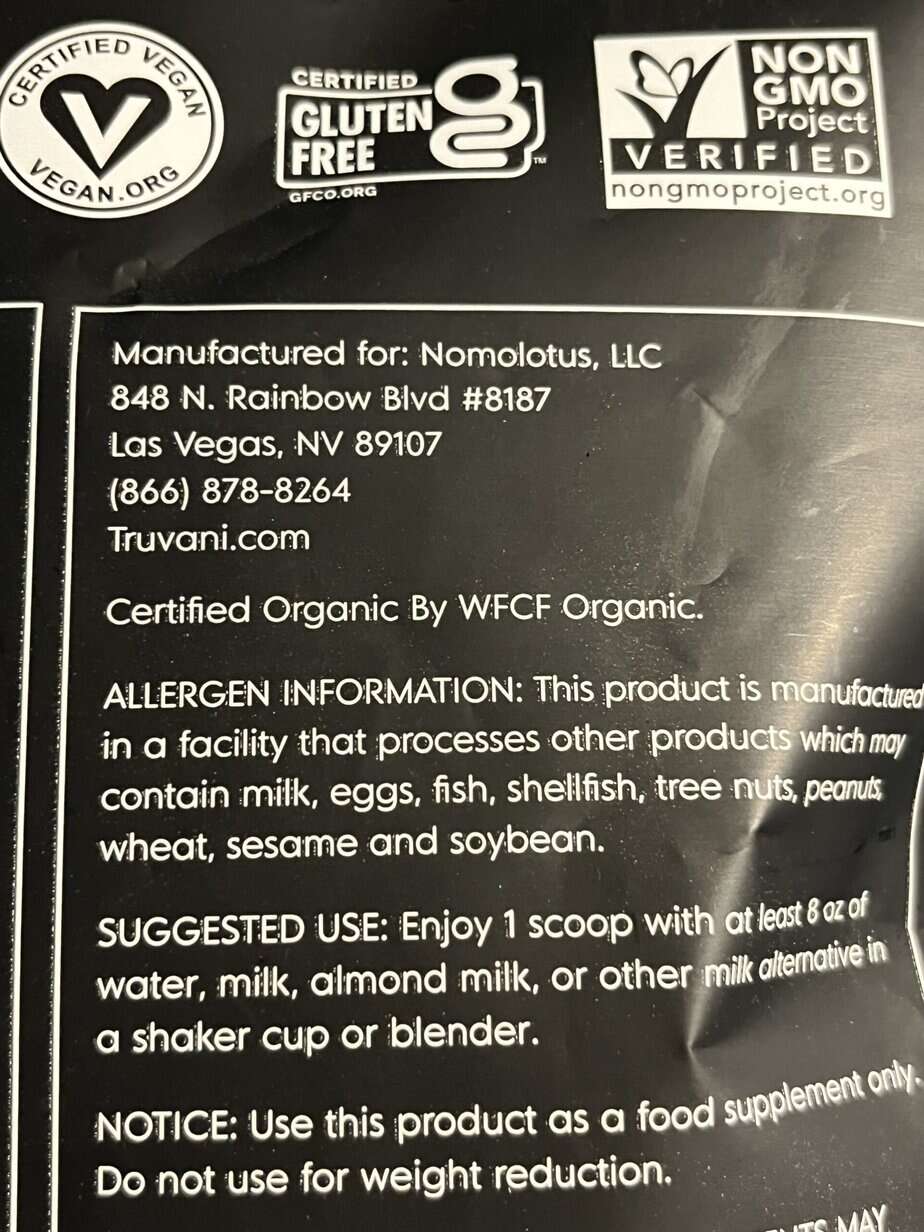
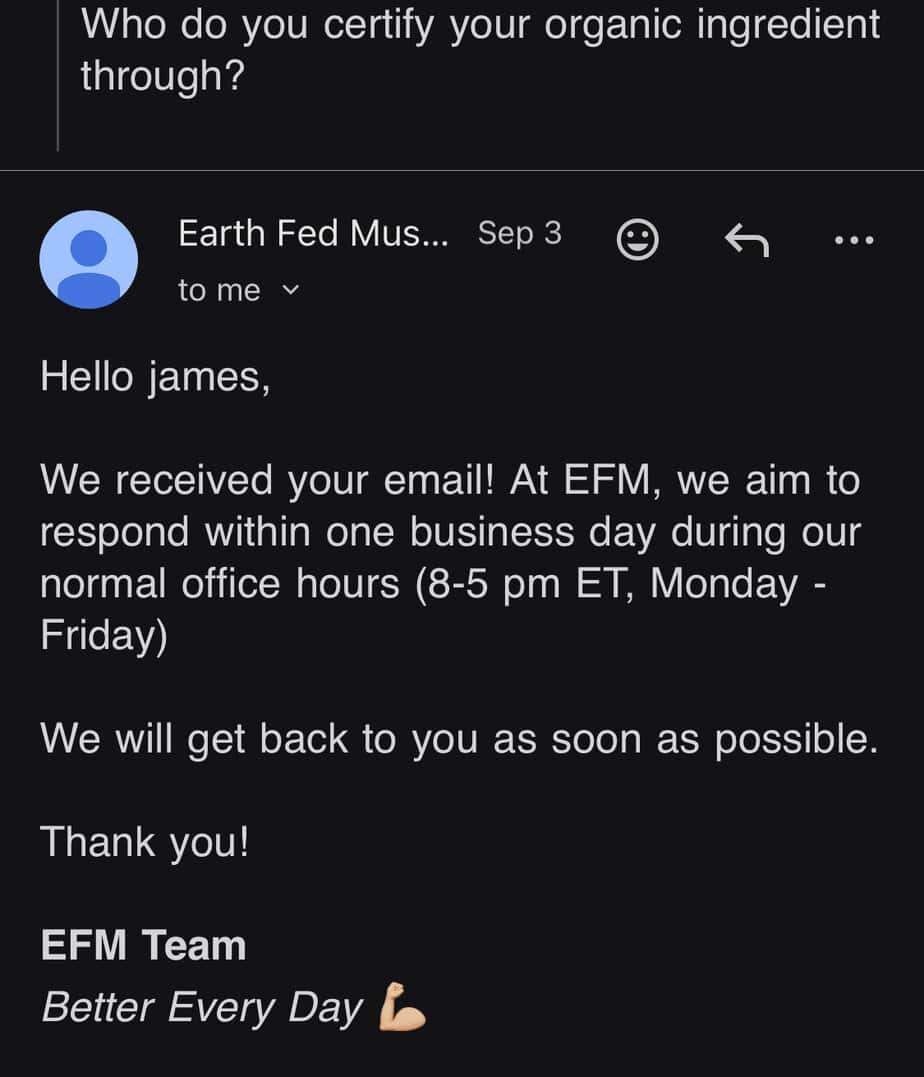
Every batch is screened, and Earth Fed Muscle Plant Protein clears Prop 65 safe-harbor limits. The brand provided COAs showing metals well below concern levels, so no Prop 65 warning appears on Common Ground tubs. Transparency-wise, that’s a positive—but because they don’t publish full toxicology reports online, cautious buyers may still want to request a COA by lot number.
The brand markets clean, soy-free, gluten-free powders, but Earth Fed Muscle Protein is not formally Non-GMO Project Verified. For shoppers who demand certification, that’s a gap. For buyers satisfied with “organic-forward” marketing, the label is serviceable, but again, it relies on trust, not third-party validation.
Each scoop lists around 1.1–1.2 g leucine, depending on flavor. Since research shows muscle protein synthesis requires ~2.5–3.0 g per meal, you’ll need two to three scoops of Common Ground—or pair one scoop with leucine-rich foods like dairy or eggs—to hit the threshold. That’s why the Earth Fed Muscle Protein review treats this more as a light daily shake than a single-scoop recovery formula.
Yes—surprisingly so. Most vegan proteins taste like chalk or peas. In the Earth Fed Muscle Protein review, Chocolate stood out for real cocoa flavor, smooth body, and no “pea” aftertaste. Across the board, mixability is excellent: no grit, no sludge, just a velvety sip in cold water.
🏁 Earth Fed Muscle Plant Protein Review
Before you hit buy now, here are the three things that matter most from this Earth Fed Muscle review:
- Protein yield is lower than the label suggests. The tub prints 15 g per scoop, but the math lands closer to 10–12 g usable protein once pea and hemp digestibility are factored in. It’s not amino spiking, but it is label optimism.
- Transparency gaps weaken the “organic” story. Earth Fed Muscle Plant Protein lists “organic” on the panel, yet there’s no USDA Organic seal or certifier disclosed. Add in the vague “natural flavors” (second in Vanilla, third in Chocolate), and the branding feels cleaner than the paperwork.
- Flavor and mixability are the true strengths. Where this formula shines is in the cup. The Earth Fed Muscle Protein review found that Chocolate delivers real cocoa taste with velvety mixability, and Chocolate Peanut Butter offers the best balance of flavor versus protein density.
Bottom Line: If taste and texture are your priorities, Earth Fed Muscle Protein is a pleasure to use. But if you value transparency and protein integrity above all, the gaps in certification and amino verification should give you pause.
✅ Is Earth Fed Muscle Legit?
This Earth Fed Muscle review reveals a brand that excels at first impressions—short ingredient lists, clean labeling, and strong flavor execution—but falls short when you hold the marketing up to scrutiny.
Who should buy Earth Fed Muscle Plant Protein?
This isn’t a muscle-builder’s dream formula. If your goal is muscle protein synthesis (MPS), the numbers don’t lie: ~1.1 g leucine per scoop means you’ll need 2–3 scoops to reach the threshold science says is necessary for maximal recovery. That makes it less practical for gym-goers looking to maximize protein efficiency. Where it fits best is as a daily vegan shake for casual users or weight-conscious buyers, since it’s light on calories, mixes easily, and avoids soy, gluten, and artificial additives.
This Earth Fed Muscle Protein review shows this powder’s main role is to serve as a plant-based lifestyle shake, not an athlete’s performance staple. The formula leans on Supplement Facts wiggle room, a self-reported amino table, and “organic” claims without a certifier. That doesn’t scream outright fraud, but it does blur the line between premium branding and protein integrity. For a $60 tub, that gap feels more like a brand playing the badge game than delivering hard proof.
This Earth Fed Muscle Protein review lands at 29/50, or 58%. Ehhh. Common Ground may be the best-tasting plant protein powder on the market, but taste isn’t enough. Without verified “organic” backing, transparent amino testing, or stronger protein-per-scoop performance, the shine wears off fast. This isn’t a scam—it’s a niche lifestyle product dressed as high-performance fuel.
Strengths: Fantastic mixability, clean flavor (especially Chocolate), and NSF safety testing.
Weaknesses: Protein density averages just 43%, usable protein hovers around 10–12 g (not the 15 g advertised), and there’s zero third-party verification on amino acid data. The “organic” label, without certification, is the final red flag.
Are you looking for more protein reviews? Here are all of JKremmer Fitness unbiased protein powder reviews. Are you looking for a protein review that I haven’t done yet? Email me at my ‘Contact Me’ page, and I’ll do my best to get an unbiased review out in 4 weeks.
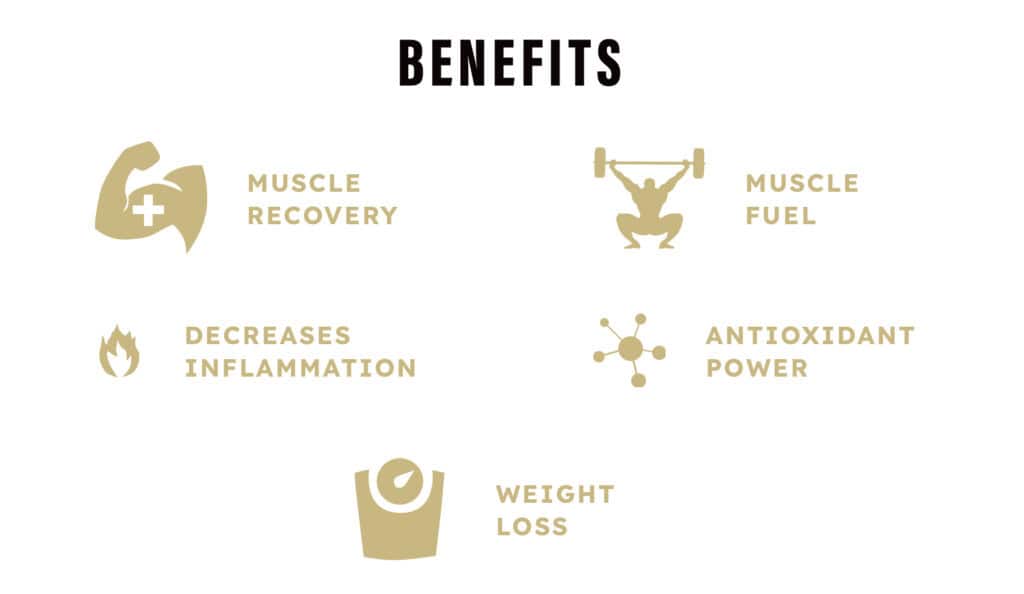
🧐 Earth Fed Muscle Plant Protein Review Round-Up
| Category | Score |
| Value | 4.5 out of 10 |
| Amino Spiking | 2.5 out of 10 |
| Mixability | 10 out of 10 |
| Ingredient List | 8.0 out of 10 |
| Nutrition Facts | 4.0 out of 10 |
| Overall Score | 29/50, 58%, Ehhh |
📑 Earth Fed Muscle Plant Protein Review Sources
21 CFR § 101.4 – Food; designation of ingredients. (n.d.). LII / Legal Information Institute. ttps://www.law.cornell.edu/cfr/text/21/101.4
21 CFR § 101.9 – Nutrition labeling of food. (n.d.). LII / Legal Information Institute. https://www.law.cornell.edu/cfr/text/21/101.9
21 CFR § 101.22 – Foods; labeling of spices, flavorings, colorings and chemical preservatives. (n.d.). LII / Legal Information Institute. https://www.law.cornell.edu/cfr/text/21/101.22
21 CFR § 101.36 – Nutrition labeling of dietary supplements. (n.d.). LII / Legal Information Institute. https://www.law.cornell.edu/cfr/text/21/101.36
Churchward‐Venne, T. A., Burd, N. A., Mitchell, C. J., West, D. W. D., Philp, A., Marcotte, G. R., Baker, S. K., Baar, K., & Phillips, S. M. (2012). Supplementation of a suboptimal protein dose with leucine or essential amino acids: effects on myofibrillar protein synthesis at rest and following resistance exercise in men. The Journal of Physiology, 590(11), 2751–2765. https://doi.org/10.1113/jphysiol.2012.228833
Earth Fed Muscle. (n.d.). Earth fed muscle. https://www.earthfedmuscle.com/pages/meet-the-team
House, J. D., Neufeld, J., & Leson, G. (2010). Evaluating the Quality of Protein from Hemp Seed (Cannabis sativa L.) Products Through the use of the Protein Digestibility-Corrected Amino Acid Score Method. Journal of Agricultural and Food Chemistry, 58(22), 11801–11807. https://doi.org/10.1021/jf102636b
Mæhre, H., Dalheim, L., Edvinsen, G., Elvevoll, E., & Jensen, I. (2018). Protein Determination—Method Matters. Foods, 7(1), 5. https://doi.org/10.3390/foods7010005
Muscle, E. F. (2023, March 20). Plant Protein vs. Grass-Fed Protein: Which Is Better? Earth Fed Muscle. https://www.earthfedmuscle.com/blogs/articles/plant-protein-vs-grass-fed-protein-which-is-better
Muscle, E. F. (2024, August 8). Returns. Earth Fed Muscle Knowledge Base. https://earth-fed-muscle.helpscoutdocs.com/article/29-returns
Stark, M., Lukaszuk, J., Prawitz, A., & Salacinski, A. (2012). Protein timing and its effects on muscular hypertrophy and strength in individuals engaged in weight-training. Journal of the International Society of Sports Nutrition, 9(1). https://doi.org/10.1186/1550-2783-9-54
USDA National Nutrient Database for Standard Reference Legacy. (2018). Nutrient content in household measure. https://www.nal.usda.gov/sites/default/files/page-files/leucine.pdf
Younes, M., Aggett, P., Aguilar, F., Crebelli, R., Dusemund, B., Filipič, M., Frutos, M. J., Galtier, P., Gott, D., Gundert‐Remy, U., Kuhnle, G. G., Leblanc, J., Lillegaard, I. T., Moldeus, P., Mortensen, A., Oskarsson, A., Stankovic, I., Waalkens‐Berendsen, I., Woutersen, R. A., . . . Lambré, C. (2018a). Re‐evaluation of silicon dioxide (E 551) as a food additive. EFSA Journal, 16(1). https://doi.org/10.2903/j.efsa.2018.5088
Zaromskyte, G., Prokopidis, K., Ioannidis, T., Tipton, K. D., & Witard, O. C. (2021). Evaluating the leucine trigger hypothesis to explain the post-prandial regulation of muscle protein synthesis in young and older adults: A Systematic review. Frontiers in Nutrition, 8. https://doi.org/10.3389/fnut.2021.685165
Zeng, Y., Chen, E., Zhang, X., Li, D., Wang, Q., & Sun, Y. (2022). Nutritional Value and physicochemical Characteristics of Alternative Protein for Meat and Dairy—A Review. Foods, 11(21), 3326. https://doi.org/10.3390/foods11213326
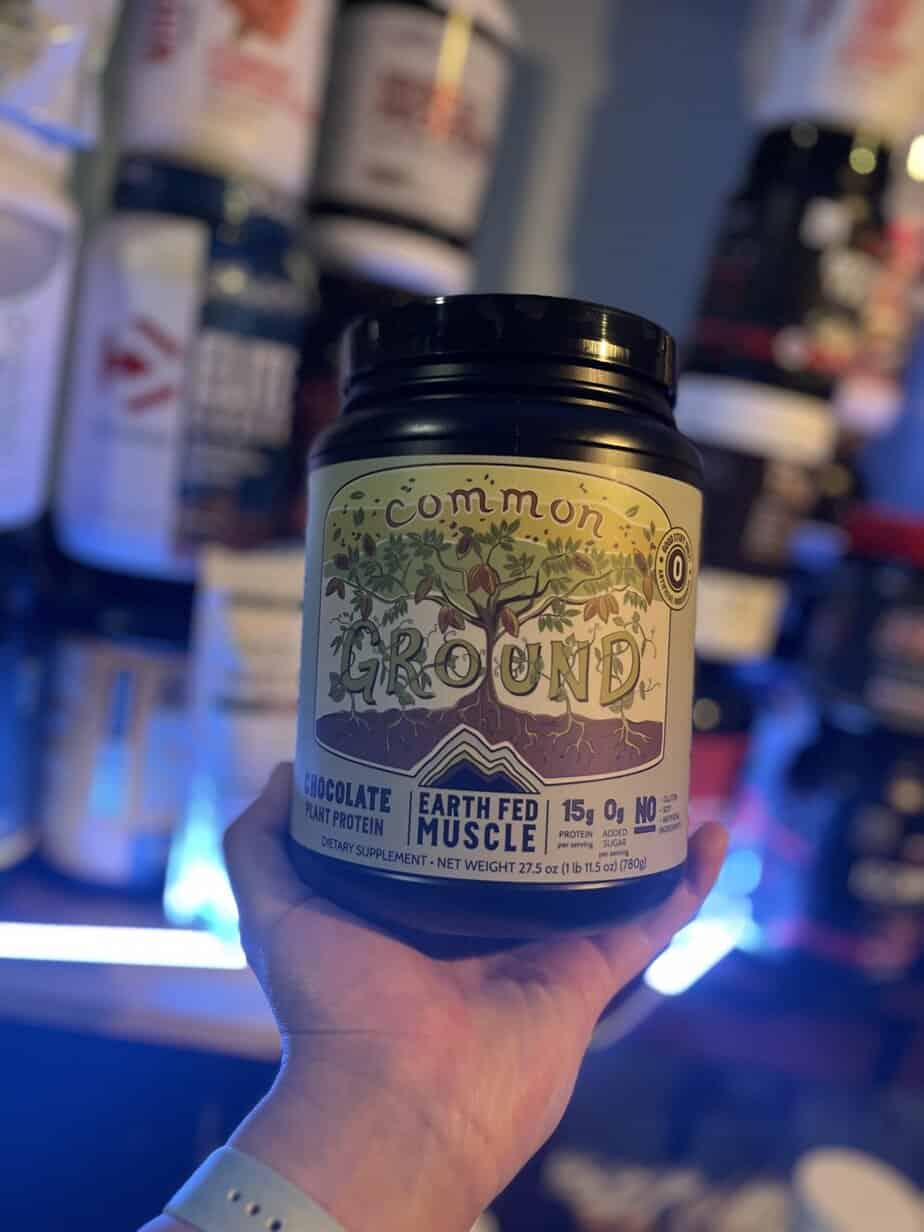
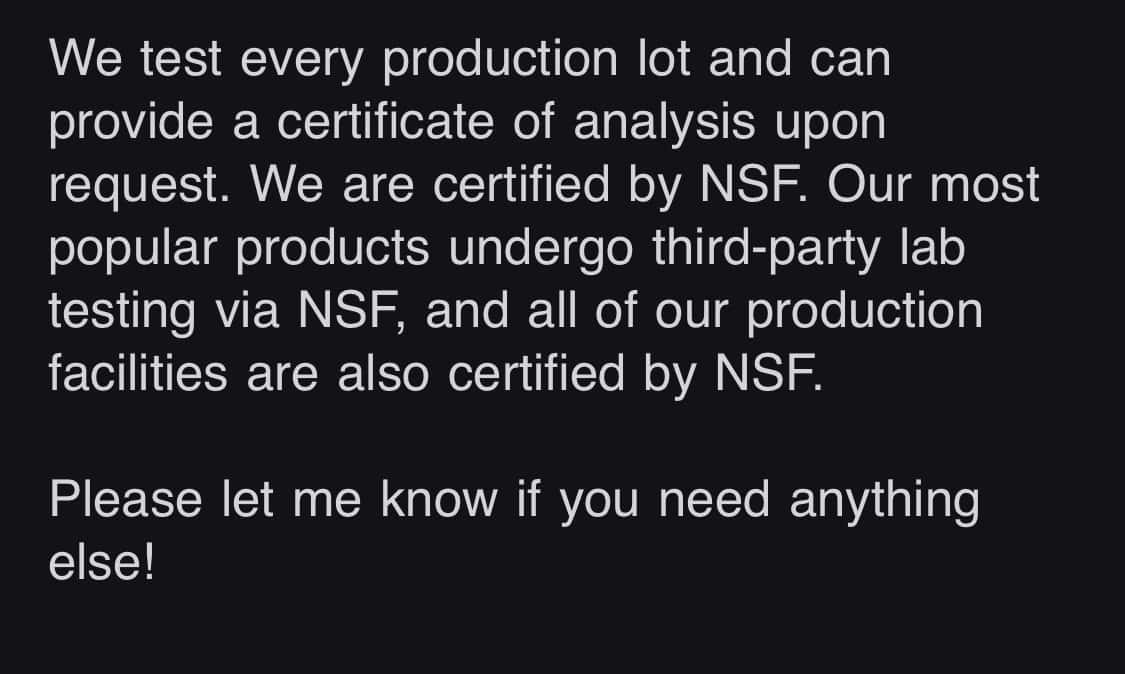
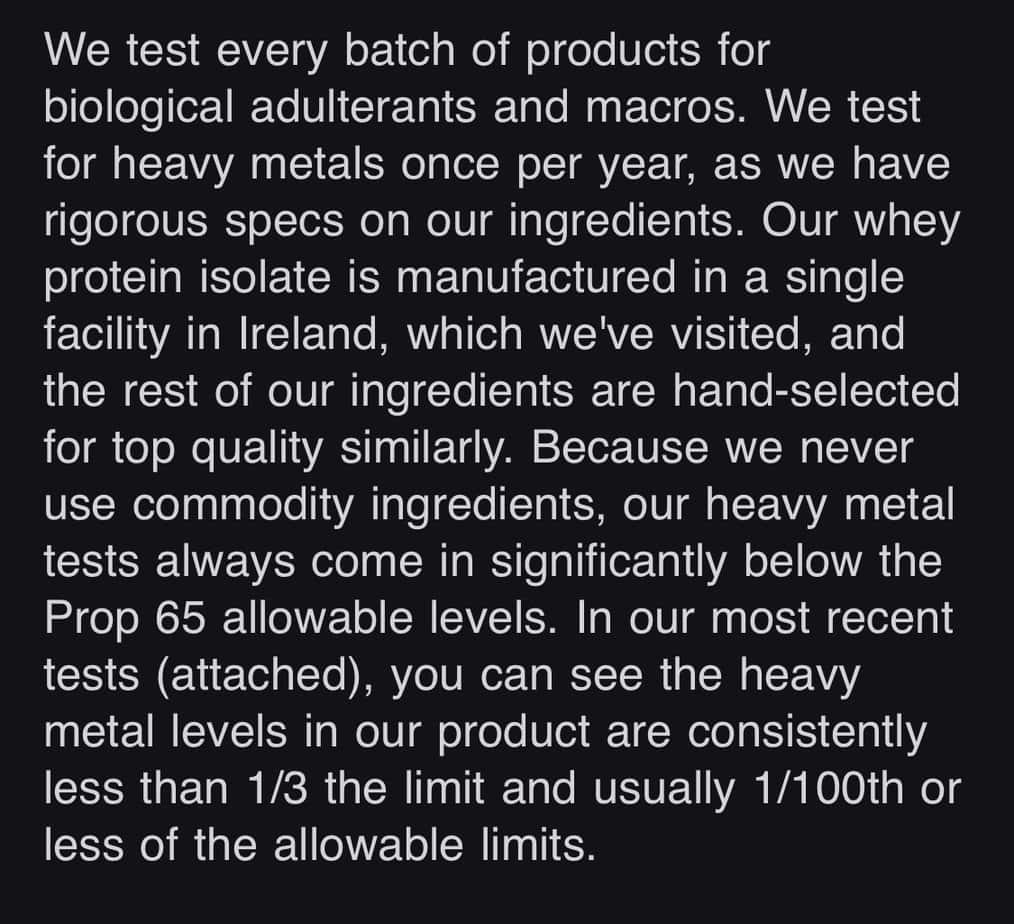

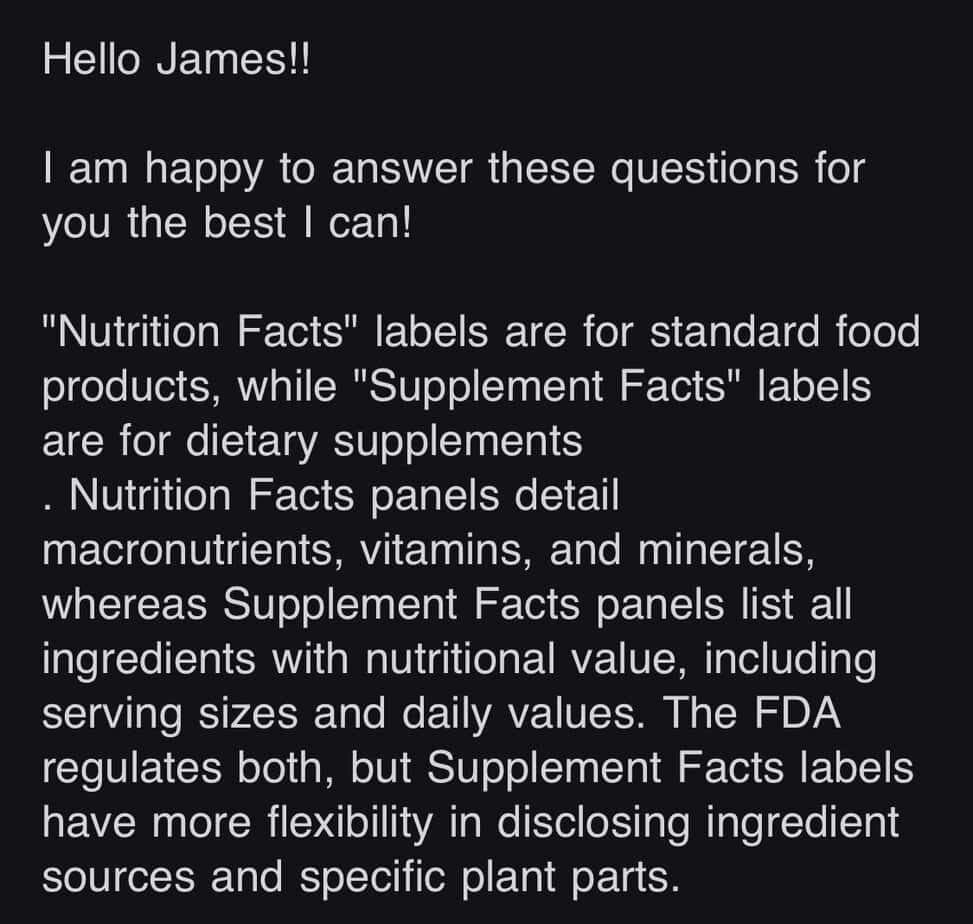
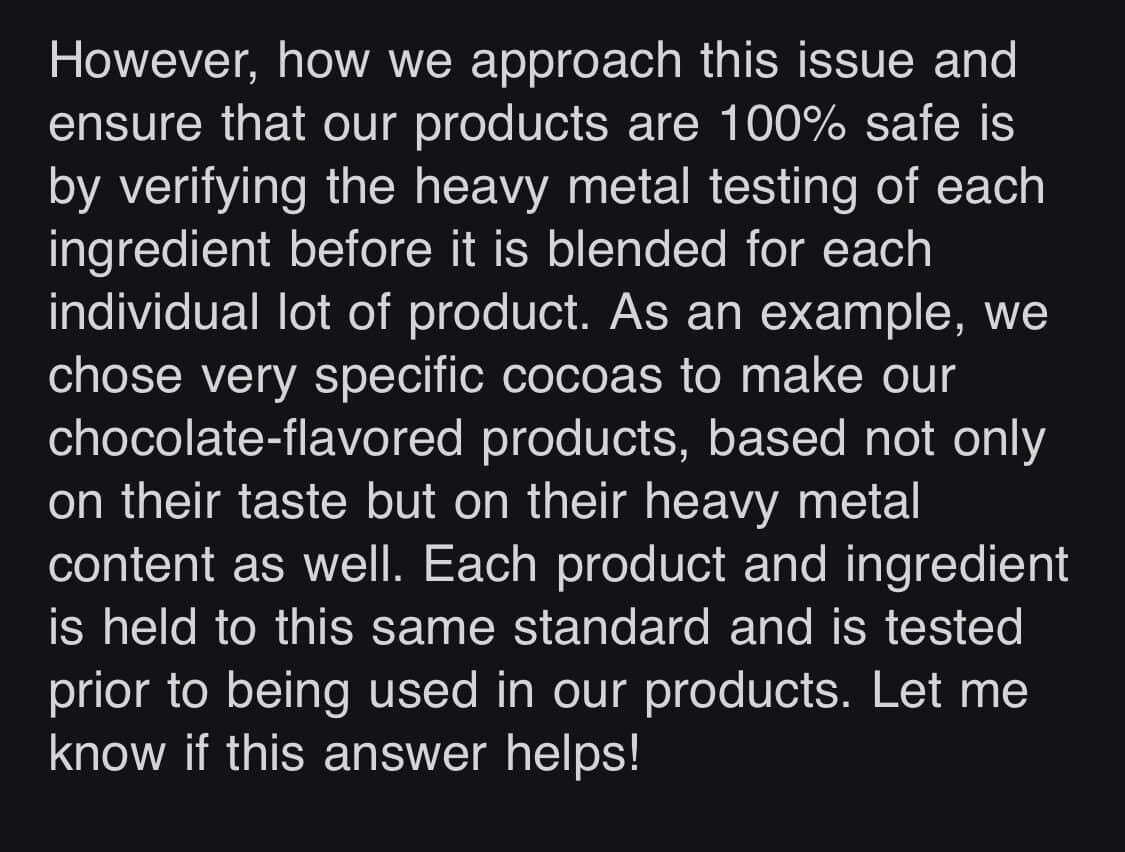
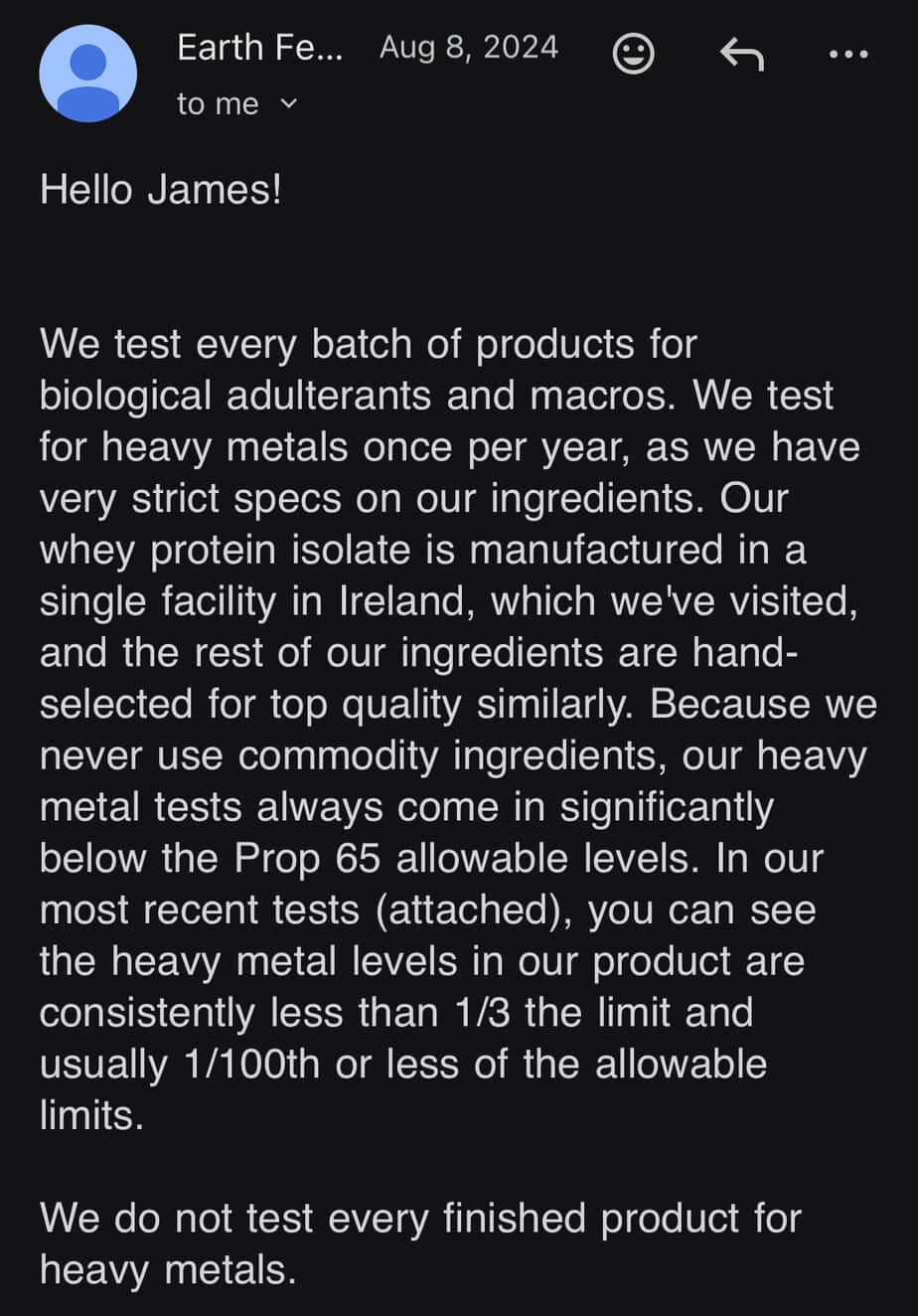

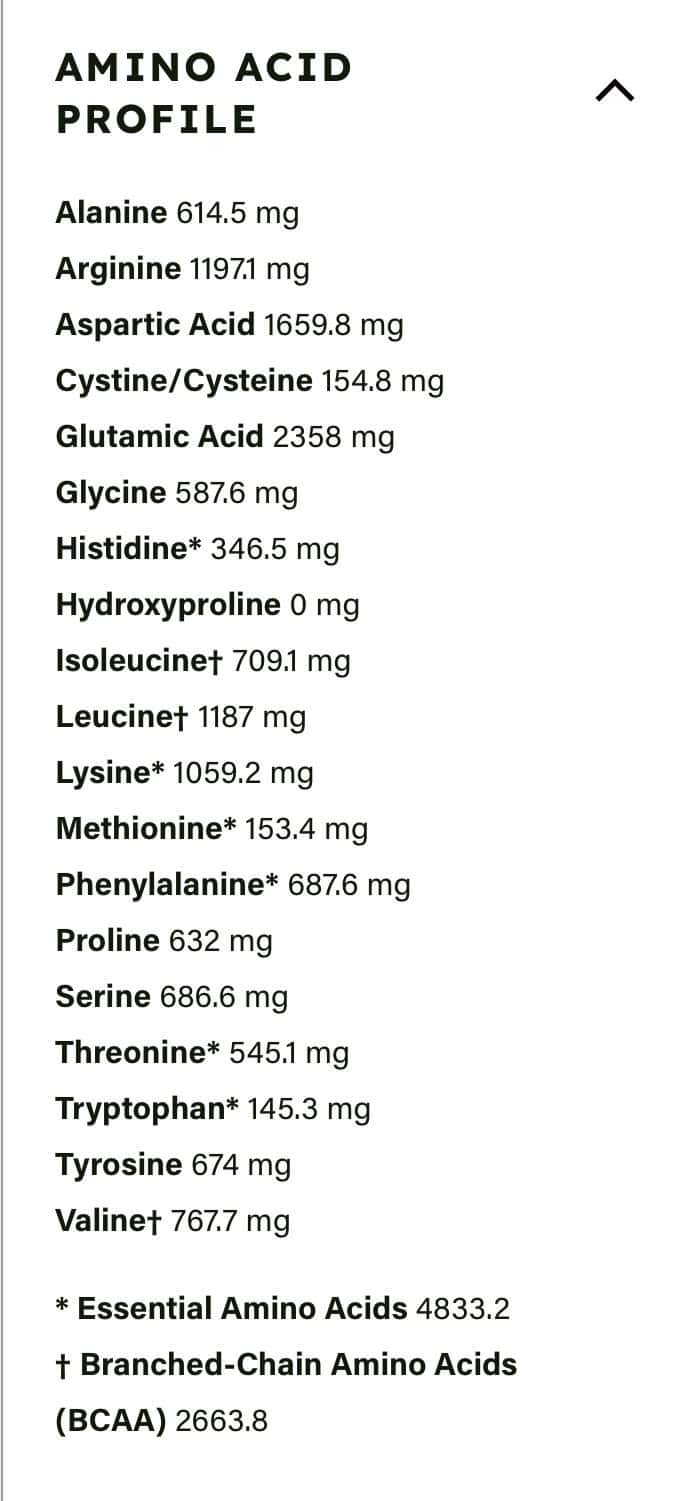


Leave a Reply